 Powering Nepal: 5 Decades of ADB–Nepal Partnership in the Energy SectorAmong the projects transforming Nepal's energy sector in terms of energy sufficiency and regional cooperation is the SASEC Power System Expansion Project, which is the largest energy project implemented by ADB in Nepal. The project will construct transmission lines that could evacuate up to 2 gigawatts (GW) of electricity from the Kali Gandaki and Marsyangdi river basins. It will also develop infrastructure to facilitate exports of at least 1.2 GW of power to India and scale up on- and off-grid renewable energy supply in Nepal. Another project, the SASEC Power Transmission and Distribution System Strengthening Project, will strengthen transmission substations to support electricity exports and upgrade medium-voltage and low-voltage distribution networks to provide quality and reliable electricity supply to 850,000 new and existing customers in Madhesh Province. Author: Asian Development Bank Year: 2024 Download Tags: Renewable Energy, Nepal, ADB, SASEC, India 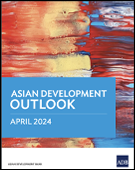 Asian Development Outlook (ADO) April 2024Robust growth is forecast for South Asia in fiscal year (FY) 2024, driven by strong gains in investments, consumption, and the electronics and services sectors. Gross domestic product (GDP) is estimated at 6.3% in FY2024 and 6.6% in FY2025 in South Asia. In Bangladesh, GDP growth is projected at 6.1% in FY2024 behind the growth of traditional low-end garments. Bhutan's projected GDP is at 4.4% given major developments in the country's hydropower sector. In India, GDP is forecast at 7.0% in FY2024, after a strong momentum in manufacturing and services in FY2023 and with exports expected to pick up in FY2025 with the rise in global growth. Growth in Maldives is estimated at 5.4% in FY2024 supported by tourism and construction. Nepal is estimated to grow at 3.6% backed by hydroelectric production and domestic demand. Amid recovery efforts in Sri Lanka, modest growth at 1.9% is forecast for the country in FY2024. In Southeast Asia, Myanmar’s GDP is projected to remain low at 1.2%. Author: Asian Development Bank Year: 2024 Download Tags: South Asia, ADB, Hydropower, Tourism, Bangladesh, Bhutan, India, Maldives, Myanmar, Nepal, Sri Lanka Energy Trade in South AsiaCountries are shifting to using green energy sources to meet their energy needs and cut emissions. While South Asia may have ample renewable energy and hydropower resources, demand exceeds local supply, and the countries have had to rely heavily on imports. To help improve energy security in the region, South Asian countries have signed bilateral and multilateral agreements to trade energy, including India-Nepal hydropower projects and the India-Bhutan hydroelectric joint venture. Author: CUTS International Year: 2023 Download Tags: Energy, Trade, South Asia, Hydropower, Bhutan, India, Nepal  Expanding Opportunities: Toward Inclusive GrowthGDP in South Asia is estimated to grow at 5.6% in fiscal year FY2023 and 5.9% in FY2024, backed by the recovery in services and lower commodity prices. GDP growth in Bangladesh will decelerate to 5.2% in FY2022-2023 due to global economic uncertainty, before recovering to 6.2% in FY2024. In Bhutan, GDP is projected to expand at 4.5% in FY2022-2023 as the further reopening of borders support growth in industry and services. GDP growth in India will moderate to 6.3% in FY2023-2024 following slower growth in consumption. Maldives is seeing a return to the tourism sector's pre-pandemic levels with GDP growth projections in FY2023 at 6.6%. Growth in Nepal will slow to 4.1% in FY2023 following import restrictions, before rising to 4.9% in FY2024. In Sri Lanka, amid fiscal and external imbalances, GDP growth is estimated at -4.3% in FY2023 and 1.2% FY2024. In Southeast Asia, the Myanmar Economic Monitor projects Myanmar's economic recovery accelerating to 3% in the year to September 2023 following growth in industry and services. Author: World Bank Year: 2023 Download Tags: WB, Bangladesh, Bhutan, Sri Lanka, Services, India, Maldives, Myanmar, Nepal Basic Statistics 2023Basic Statistics presents data on development indicators tracking progress toward the Sustainable Development Goals. The publication includes new data for development indicators for 46 economies in Asia and the Pacific, including those for the seven South Asia Subregional Economic Cooperation countries: Bangladesh, Bhutan, India, Maldives, Myanmar, Nepal, and Sri Lanka. Author: Asian Development Bank Year: 2023 Download Tags: Bangladesh, Bhutan, India, Myanmar, Maldives, Nepal, Sri Lanka, Sustainable Development Goals 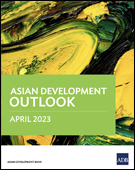 Asian Development Outlook (ADO) April 2023South Asia is projected to grow faster than other subregions in Asia, with real gross domestic product (GDP) estimated at 5.5% in fiscal year (FY) 2023 and 6.1 in FY2024. Growth within South Asia is expected to vary, with India projected to grow by 6.4% in FY2023 and 6.7% in FY2024 behind strong domestic demand. In Bangladesh, GDP growth is estimated at 5.3% in FY2023 owing to global economic disruptions and 6.5% in FY2024. In Bhutan, hydropower production will push up growth to 4.6% in FY2023 and 4.2% in FY2024. Growth in Maldives is estimated at 7.1% in FY2023 and 6.9% in FY2024, supported by a boom in tourism and construction. In Nepal, growth will slow to 4.1% this year before picking up in FY2024 at 5.0% with a recovery in tourism and infrastructure. Sri Lanka is projected to contract at -3.0% in FY2023 before recovering to 1.3% in FY2024 premised on debt relief and key reforms. In Southeast Asia, Myanmar's GDP will rise moderately to 2.8% in FY2023 and 3.2% in FY2024. Author: Asian Development Bank Year: 2023 Download Tags: South Asia, Hydropower, ADB, Bangladesh, Bhutan, India, Maldives, Myanmar, Nepal, Sri Lanka Identifying Challenges and Improving Trade Facilitation in the States of Northeast IndiaThe northeast of India is shares international borders with Bangladesh, Bhutan, Nepal, and Myanmar and acts as a bridge for India's participation in global forums through the Bay of Bengal Initiative for Multisectoral Technical and Economic Cooperation and the South Asia Subregional Economic Cooperation program. This paper highlights challenges in global trade and suggests ways for improving trade with other countries in South Asia and Southeast Asia. Author: Sanchita Basu Das and Soumya Chattopadhyay Year: 2023 Download Tags: India, Trade Facilitation, SASEC, BIMSTEC, Transport, Bangladesh, Bhutan, Nepal, Myanmar Significance of Padma Bridge in South Asia's ConnectivityThe Padma Bridge will improve connectivity and increase trade in the Bangladesh. The bridge increases connectivity in Bangladesh and is projected to improve the quality of life among nearby communities. The economies of nearby countries also stand to benefit, as the bridge improves connectivity among Bhutan, India, and Nepal, and improves mobility of people, goods, and essential services. Author: CUTS International Year: 2022 Download Tags: Transport, Trade, BBIN, Bangladesh, Bhutan, India, Nepal  Asian Development Outlook (ADO) 2022 Update: Entrepreneurship in the Digital AgeGrowth forecast in South Asia is projected at 6.5% in fiscal year (FY) 2022 and FY2023. In Bangladesh, gross domestic product (GDP) growth is projected at 7.2% in FY2022 and 6.6% in FY2023, reflecting lower consumption spending. Growth in Bhutan is forecast to grow at 4.5% in FY2022 and 4.0% in FY2023 as government investment continues as a key driver of growth. In India, weaker than expected global demand is expected to affect growth, projected at 7.0% for FY2022 and 7.2% for FY2023. GDP growth in Maldives is forecast at 8.2% in FY2022 and 10.4% in FY2023 with continued tourism arrivals. In Nepal, GDP is projected at 5.8% in FY2022 and 4.7% in FY2023, affected in part by needed policy tightening to address rapid rise in imports. Contractions are projected for Sri Lanka, -8.8% in FY2022 and -3.3% in FY2023, likely resulting from severe macroeconomic challenges, including the impact of the ongoing crisis. In Southeast Asia, Myanmar's GDP is forecast at 2.0% in FY2022 and 2.6% in FY2023 owing to an improvement in economic activity. Author: Asian Development Bank Year: 2022 Download Tags: ADB, Bangladesh, Bhutan, India, Maldives, Myanmar, Nepal  Reshaping Norms: A New Way ForwardSouth Asian countries are emerging from coronavirus (COVID-19) pandemic burdened by high inflation and fiscal imbalances, as well as external shocks. In Bangladesh, gross domestic product (GDP) is projected to increase by 6.4% in fiscal year (FY) 2021-2022 and 6.7% in FY2022-2023. In Bhutan, FY2021-2022 growth is estimated at 4.4% and FY2022-2023 growth at 4.7%, with the expected return of international tourists and migrant workers from India. In India, FY2022-2023 growth is projected at 8%, slightly below last year’s rate. Economic recovery in Maldives will stay strong in 2022, with real GDP growth expected to grow by 8.5% in 2022 and 9.1% in 2023. In Nepal, tourism has yet to recover, with growth projected at 3.7% in FY2021-2022 and 4.1% in FY2022-2023. Hydropower in Nepal is providing a natural hedge against increases in crude oil-based energy prices. Growth in Sri Lanka is hampered by a series of shocks amid high debt, with 2022 growth projected at 2.4%. Author: World Bank Year: 2022 Download Tags: WB, South Asia, Bangladesh, Bhutan, India, Maldives, Nepal, Sri Lanka Basic Statistics 2022Basic Statistics presents economic, environmental, and social indicators used to track progress toward the Sustainable Development Goals. The publication includes new data for development indicators for 46 economies in Asia and Pacific, including those for the seven South Asia Subregional Economic Cooperation countries: Bangladesh, Bhutan, India, Maldives, Myanmar, Nepal, and Sri Lanka. Author: Asian Development Bank Year: 2022 Download Tags: Bangladesh, Bhutan, India, Maldives, Myanmar, Nepal, Sri Lanka, Trade, Sustainable Development Goals, Renewable Energy 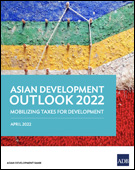 Asian Development Outlook (ADO) 2022: Mobilizing Taxes for DevelopmentGrowth in South Asia is projected to remain strong at 7.0% in FY2022 and 7.4% in FY2023 as the region’s economies try to catch up to pre-pandemic levels. In Bangladesh gross domestic product (GDP) growth is projected at 6.9% in FY2022. Growth in FY2023, projected at 7.1%, will be driven by private consumption. Bhutan is forecast to grow at 4.5% in FY2022. Growth will accelerate to 7.5% in FY2023 with the reopening of international tourism in the country. India is forecast to grow at 7.5% in FY2022 and 8.0% in FY2023, buoyed by strong investment growth. GDP growth in Maldives is forecast at 11.0% in FY2022 and 12.0% in FY2023 with continued tourism arrivals. In Nepal, fiscal stimulus and wider vaccination coverage will support growth, projected at 3.9% in FY2022 and 5.0% in FY2023. Sri Lanka's growth is forecast to slow to 2.4% in FY2022 and pick up to 2.5% in FY2023 amid low foreign exchange reserves. In Southeast Asia, Myanmar’s economy is forecast to contract in FY 2022 on protracted political instability. Myanmar GDP is forecast at -0.3% in FY2022 and 2.6% in FY2023. Author: Asian Development Bank Year: 2022 Download Tags: ADB, Bangladesh, Bhutan, India, Nepal, Sri Lanka, Maldives, Myanmar Basic Statistics 2021Basic Statistics 2021 presents development indicators—tracking the progress made by countries in achieving the Sustainable Development Goals. It includes data for 46 economies in Asia and the Pacific, including those for the seven South Asia Subregional Economic Cooperation countries: Bangladesh, Bhutan, India, Maldives, Myanmar, Nepal, and Sri Lanka. Author: Asian Development Bank Year: 2021 Download Tags: Bangladesh, Bhutan, India, Maldives, Myanmar, Nepal, Sri Lanka, Trade, Sustainable Development Goals, Renewable Energy Assam as India's Gateway to ASEANAssam's location in northeast India offers opportunities for enhancing cross-border trade and developing regional economic corridors spanning Bangladesh, Bhutan, India, Nepal, and countries in Southeast Asia. By developing trade and economic corridors, Assam aims to build on its vision of becoming a $75 billion economy by 2025. Author: Asian Development Bank Year: 2021 Download Tags: ASEAN, Bangladesh, Bhutan, India, Nepal, Regional Cooperation, Trade, ADB RCI Making BIMSTEC a Regional Vehicle for Nepal's Economic GrowthThe Bay of Bengal Initiative for Multi-Sectoral Technical and Economic Cooperation (BIMSTEC) was established in 1996 with a permanent secretariat in Dhaka, Bangladesh. Nepal, which joined BIMSTEC in 2004, could achieve its goals of development and prosperity through the organization. Nepal could expand its trade, economy, business, investments, and cultural connections through connections with BIMSTEC member countries in South and Southeast Asia. Author: Sunil K.C. Year: 2021 Download Tags: BIMSTEC, Nepal, Trade Harnessing Inland Waterways for Inclusive Trade Among Bay of Bengal CountriesThe transboundary rivers Ganges, Brahmaputra, and Meghna create a vibrant water grid connecting Bangladesh, Bhutan, India, and Nepal. India has been developing fairways and river and multimodal terminals in the last few years. Further development of inland waterways in Bay of Bengal countries would create jobs and open opportunities for inclusive trade. Author: Veena Vidyadharan Year: 2021 Download Tags: Bangladesh, Bhutan, India, Inland Waterways, Nepal, Trade, Transport 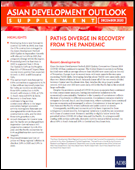 Asian Development Outlook (ADO) 2020 Supplement: Paths Diverge in Recovery from the PandemicThis publication provides updated economic forecasts for Asia and the Pacific. In South Asia, the earlier forecast of 6.8% contraction in 2020 is upgraded to 6.1%. Growth in South Asia is expected to return in 2021 at 7.2%. This is in line with improved prospects for India, where contraction is projected at 8.0% in 2020 and growth is projected at 8.0% in 2021. In Bangladesh, growth in exports and remittances backed economic activity. In Bhutan, the impact of the coronavirus disease (COVID-19) pandemic is expected to be greater than projected. Travel demand remains weak in Maldives and is hampering recovery. In Nepal, a persistent rise in COVID-19 infections holds back demand. Resurgent outbreaks in Sri Lanka’s export and tourist markets are expected to worsen contraction in 2020. Author: Asian Development Bank Year: 2020 Download Tags: South Asia, India, Bhutan, Sri Lanka, Nepal, Bangladesh, Maldives, Tourism, COVID-19, Export Basic Statistics 2020Basic Statistics presents select economic, environmental, and social indicators used to track progress toward the Sustainable Development Goals. It includes new data for development indicators for 46 economies in the Asia and Pacific region, including those for the seven South Asia Subregional Economic Cooperation countries: Bangladesh, Bhutan, India, Maldives, Myanmar, Nepal, and Sri Lanka. Author: Asian Development Bank Year: 2020 Download Tags: Sustainable Development Goals, Bangladesh, Bhutan, India, Maldives, Myanmar, Nepal, Sri Lanka Role of Multi-modal Connectivity in Fostering Value Chains in the BBIN Sub-regionThis report looks at how multimodal connectivity can strengthen regional value chains in the Bangladesh, Bhutan, India, Nepal (BBIN) subregion. It also provides a snapshot of various multimodal connectivity initiatives, such as the South Asia Subregional Economic Cooperation (SASEC) Road Connectivity Investment Program, the inland waterways agreement between Bhutan and Bangladesh, and the railway link between Raxaul (India) and Sirsiya (Nepal). Author: CUTS International Year: 2020 Download Tags: Bangladesh, Bhutan, India, Nepal, Rail, Road, Transport, SASEC Asian Development Outlook (ADO) 2020: What Drives Innovation in Asia?Growth in developing Asia is forecast to slow to 2.2% in fiscal year (FY) 2020 due to the effects of the global health emergency. In South Asia, growth will decelerate to 4.1% in FY2020 and rebound to 6.0% in FY2021 following a projected revival in India. Bangladesh is projected to grow by 7.8% this fiscal year and 8.0% in FY2021. GDP growth in Bhutan, despite lower tourist arrivals, will accelerate on high government spending. Growth in Maldives and Sri Lanka will be constrained this year due to weaker tourism. In Nepal, the outlook is for moderating growth. In Southeast Asia, Myanmar growth is expected to slow in FY2020 and pick up in FY2021. Author: Asian Development Bank Year: 2020 Download Tags: ADB, Bangladesh, Bhutan, India, Maldives, Myanmar, Nepal, Sri Lanka, Tourism, FDI Asian Development Outlook (ADO) 2019 Supplement, December: Growth Slows Further in Developing Asia’s GiantsDeveloping Asia's gross domestic product is projected to grow by 5.2% both in 2019 and 2020 as a slowing of global economic activity tempers regional growth, according to the Asian Development Outlook (ADO) 2019 Supplement. In South Asia, growth forecasts have been lowered to 6.1% in 2020. Strong remittances in Bangladesh will raise domestic demand, while in Bhutan, hydropower production rose to 3.1% in Q1 of FY2020 (ending 30 June 2020). Growth in India is expected to recover to 6.5% in 2020 with government policy measures, such as a corporate tax cutt and policy rate reduction. In Maldives, tourism remains strong. Foreign direct investments surged in Nepal while a recovery in economic activity is projected in Sri Lanka. Author: Asian Development Bank Year: 2019 Download Tags: ADB, South Asia, Hydropower, Tourism, Investment, Bangladesh, Bhutan, Maldives, Nepal, Sri Lanka South Asia: Shifting Outlook Calls For Steadfast ReformsGrowth in South Asia is projected to rise to 7.0% in 2020. To create more and better jobs, the region needs to further strengthen reforms. Growth in Bangladesh is expected to remain strong at around 8.0% in fiscal year (FY) 2019, led by private consumption and investment. In Bhutan, economic activity will pick up to around 6.0% in FY2020, supported by private consumption. In India, gross domestic product (GDP) growth slowed to 6.8% in FY2018/2019. Economic activity in Nepal remains robust as FY2018/2019 growth reached 7.1%. In Maldives, growth has been supported by increasing tourist arrivals. Economic activity in Sri Lanka is projected to recover as the tourism sector stabilizes. Author: International Monetary Fund Year: 2019 Download Tags: Bangladesh, Bhutan, India, Maldives, Nepal, Sri Lanka, Investment, Jobs, Tourism Borders without Barriers: Facilitating Trade in SASEC CountriesBorders without Barriers presents an analysis of the state of trade facilitation in member countries of the South Asia Subregional Economic Cooperation (SASEC) program. The book includes an analysis of the state of trade facilitation in Bangladesh, Bhutan, India, Nepal, and Sri Lanka, as well as in Maldives and Myanmar. It identifies trade facilitation priorities in SASEC countries: implementation of trade facilitation agreements and other conventions; logistics and infrastructure development and regulatory reforms; coordinated border management; and institutions and capacity development. Author: Asian Development Bank Year: 2019 Download Tags: ADB, SASEC, Trade Facilitation Agreement, Bangladesh, Bhutan, India, Maldives, Myanmar, Nepal, Sri Lanka, ADB RCI Infrastructure Financing for Sustainable Development in Asia and the PacificThis book proposes adopting a more holistic approach to help accelerate infrastructure development in Asia and the Pacific. It discuses project financing for Nepal’s cross-border dry ports, streamlining Nepal’s trade and transit procedures through Automated Systems for Customs Data (ASYCUDA) and Advanced Cargo Information System (ACIS), and project financing by the Asian Development Bank of the Kakarbhitta dry port and a cross-country corridor project between Bangladesh and India. Financing and technical assistance from multilateral development banks and neighboring countries not only bridge funding gaps, these also help countries learn from funders’ experience constructing and operating infrastructure assets. Author: United Nations Economic and Social Commission for Asia and the Pacific Year: 2019 Download Tags: Infrastructure, Nepal, Sustainable Development Goals, UNESCAP Bridging the East: Trade and Transport Connectivity in the Bay of Bengal RegionBangladesh, Bhutan, India, and Nepal Motor Vehicles Agreement aims to reap the trade and economic potentials of the countries of South Asia. This study identifies hurdles to the successful implementation of the agreement through evidence-based advocacy and dialogue. The study highlights issues related to infrastructure, political economy, gender, and livelihood. Author: CUTS International Year: 2019 Download Tags: Trade, Transport, BBIN, BBIN Motor Vehicles Agreement, Bangladesh, India, Bhutan, Myanmar, Nepal 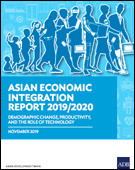 Asian Economic Integration Report 2019/2020: Demographic Change, Productivity, and the Role of TechnologyThis report reviews economic cooperation and integration in Asia and the Pacific. It reports that in 2018, the South Asia Subregional Economic Cooperation (SASEC) focused on reducing gaps in multimodal connectivity among its member countries. By the end of 2018, 52 ADB-financed projects worth $11.36 billion had been committed to SASEC projects, with an additional $106.44 million in 81 technical assistance grants. SASEC nodal officials and working groups met in Singapore in March 2018 to update the SASEC operational plan. The operational plan identified 77 projects ($45.6 billion) to be financed by SASEC members, ADB, and development partners. A holistic approach under the operational plan will build transport links with Southeast Asia and East Asia and expand regional trade markets. Author: Asian Development Bank Year: 2019 Download Tags: ADB, Regional Cooperation, SASEC, Trade Facilitation, Transport, Bangladesh, Bhutan, India, Maldives, Myanmar, Nepal, Sri Lanka Maritime Cooperation in SASEC: South Asia Subregional Economic CooperationMost South Asia Subregional Economic Cooperation (SASEC) countries rely on maritime transport for international trade. Stronger maritime relations are crucial to achieve the economic growth potential for the subregion. This report looks at how countries can strengthen international trade by improving maritime cooperation among the SASEC countries, comprised of Bangladesh, Bhutan, India, Maldives, Myanmar, Nepal, and Sri Lanka. It gives an overview of the SASEC maritime sector and identifies collaboration initiatives that could address key challenges. Author: Asian Development Bank Year: 2019 Download Tags: Transport, Trade Facilitation, Bangladesh, Bhutan, India, Maldives, Myanmar, Nepal, Sri Lanka, ADB RCI Asian Development Outlook (ADO) 2019 Update: Fostering Growth and Inclusion in Asia's CitiesGrowth in developing Asia remains strong despite the slowing down of international trade and a weakening of investments. In South Asia, growth momentum has slowed, with growth forecasts lowered to 6.2% for 2019 and retained at 6.7% for 2020. Growth in India has softened but is expected to bounce back to 7.2% in 2020. Bangladesh and Nepal performed better than projected. Bhutan’s growth slowed to 5.3% in fiscal year (FY) 2019 due to a decline in hydroelectric generation. Growth projection for FY2020 is retained at 6.0%. In Sri Lanka, growth forecast has been lowered for 2019 and 2020. Forecasts for Maldives is retained as tourist arrivals increased in the first half of 2019. In Southeast Asia, growth projections for Myanmar has been retained. Author: Asian Development Bank Year: 2019 Download Tags: Hydropower, ADB, Bangladesh, Bhutan, India, Maldives, Myanmar, Nepal, Sri Lanka Services for Trade Competitiveness: Country and Regional Assessments of Services TradeThis book applies methodologies for assessing competitiveness of countries’ services sector. It examines the types of barriers to services in the regulatory environment and identifies the policy implications. It aims to guide policymakers in the area of services in international trade. The chapter on diversifying Nepal’s economy assesses the country’s trade potential in services. Using the Services Trade Competitiveness Diagnostic toolkit, it identifies policy measures that can help Nepal identify strategies for greater integration in the global marketplace. Author: Claire Hollweg and Sebastian Saez, eds. Year: 2019 Download Tags: Energy, Nepal, Services, Trade, WB World Investment Report 2019This report monitors global and regional foreign direct investment trends and national and international investment policy developments. Foreign direct investments (FDI) in South Asia grew by 4% in 2018 to $54 billion, with India accounting for $42 billion. International cooperation in the development of special economic zones (SEZs) has been increasing. In developing countries, many SEZs are built through bilateral partnerships or as part of development cooperation programs. In South Asia, the number of SEZs is set to increase substantially. India has 200 new zones in the pipeline, while Bangladesh has 60, and Nepal 12. Author: United Nations Conference on Trade and Development Year: 2019 Download Tags: Bangladesh, India, Nepal, FDI, Investment, South Asia, UNCTAD Basic Statistics 2019Basic Statistics presents select economic, environmental, and social indicators used to track progress toward the Sustainable Development Goals. It includes indicators for development indicators for 46 economies in the Asia and Pacific region, including those for the seven SASEC countries: Bangladesh, Bhutan, India, Maldives, Myanmar, Nepal, and Sri Lanka. Author: Asian Development Bank Year: 2019 Download Tags: Bangladesh, Bhutan, India, Maldives, Myanmar, Nepal, Sri Lanka, Trade, Sustainable Development Goals, Energy Economic and Social Survey of Asia and the Pacific 2019: Ambitions beyond GrowthThe Asia-Pacific region needs an estimated $1.5 trillion per year to end poverty and hunger, provide basic health care, quality education, enabling infrastructure, and clean energy for all, and for climate action and living in harmony with nature. Available public and private resources make these ambitions affordable for most countries in the region. However, development partnerships and regional cooperation are needed for all countries to achieve these “ambitions beyond growth.” Author: United Nations Economic and Social Commission for Asia and the Pacific Year: 2019 Download Tags: Sustainable Development Goals, Bangladesh, Bhutan, India, Nepal, Maldives, Myanmar, Sri Lanka, Trade, Energy Connecting Corridors beyond Borders: Enabling Seamless Connectivity in the BBIN Subregion Trade connectivity is expected to bring economic growth and prosperity and reduce poverty in Bangladesh, Bhutan, India, and Nepal (BBIN). It will strengthen the economies of landlocked Bhutan and Nepal and give BBIN countries greater access to global markets for exports and imports. The Motor Vehicles Agreement will promote containerization of multimodal cargo movement, which will help reduce trade costs. This study identifies eight trade corridors in the BBIN countries and provides details on existing infrastructure, time-cost-distance analysis, and projected sociopolitical impact. Author: CUTS International Year: 2019 Download Tags: BBIN, BBIN Motor Vehicles Agreement, Transport, Bangladesh, Bhutan, India, Nepal Impact Evaluation of Energy Interventions: A Review of the EvidenceImpact evaluations in the energy sector has so far focused on rural electrification and improved cookstoves. However, most investments have been in power generation and transmission. This energy sector impact evaluation report assesses what has been produced against what might be possible. It summarizes outcomes of 85 impact evaluations of energy interventions in developing countries, including Bangladesh, Bhutan, India, and Nepal. It looks at evidence gaps and proposes future directions for impact evaluations in the energy sector. Author: David A. Raitzer, Nina Blöndal, and Jasmin Sibal Year: 2019 Download Tags: Energy, Bangladesh, Bhutan, Nepal, India 2018 Development Effectiveness ReviewThis report looks at the Asian Development Bank’s (ADB) performance in achieving the goals set out in ADB’s Strategy 2020. In its South Asia operations, ADB supported the linking of countries through transport connectivity. ADB has committed $180 million to rehabilitate the Kanchanpur–Kamala section of the East–West Highway in Nepal to promote safety and transport connectivity. It is also committed to a $150 million project through the South Asia Subregional Economic Cooperation Road Connectivity Investment Program to upgrade a section of the Asian Highway connecting Manipur, India, to Myanmar and construct an international bridge between India and Nepal. Author: Asian Development Bank Year: 2019 Download Tags: ADB, India, Jobs, Myanmar, Nepal, SASEC, Transport, Road Impact Evaluation of Transport Interventions: A Review of the EvidenceDevelopment of transport is integral to the development of economic corridors, regional economic integration, and trade. This publication reviews the impact of 91 transport interventions in developing countries, including Bangladesh, Bhutan, India, and Nepal. It summarizes the project outcomes, identifies evidence gaps, and presents proposals for future directions. Author: David A. Raitzer, Nina Blöndal, and Jasmin Sibal Year: 2019 Download Tags: Bangladesh, Regional Connectivity, Bhutan, India, Nepal, Rail, Road, Transport Renewable Capacity Statistics 2019This report provides renewable energy statistics for 2009–2018. It includes figures on total renewable energy capacity installed and connected by energy source (hydropower, wind energy, solar energy, etc.). It gives figures for capacity per region and per country, including those for Bangladesh, Bhutan, India, Maldives, Myanmar, Nepal, and Sri Lanka. Author: International Renewable Energy Agency Year: 2019 Download Tags: Renewable Energy, Bangladesh, Bhutan, India, Maldives, Myanmar, Nepal ADB Annual Report 2018The Asian Development Bank (ADB) supports cross-border infrastructure to help foster regional cooperation and integration. It is transforming transport corridors into economic corridors, allowing South Asian countries to participate in regional and global value chains and promote agriculture trade. In 2018, ADB committed $150 million to upgrade sections of South Asia Subregional Economic Cooperation (SASEC) road corridors in India and Nepal. The investments aim to improve connectivity between Manipur (in India) and Myanmar; build an India–Nepal international bridge; and improve the safety of Nepal’s East–West Highway. ADB also approved a technical assistance project to build institutional capacity and improve expertise of trade facilitation officials in SASEC member countries. Author: Asian Development Bank Year: 2019 Download Tags: Economic Corridor Development, ADB, Energy, India, Nepal, SASEC, Trade Facilitation Asian Development Outlook (ADO) 2019: Strengthening Disaster ResilienceDeveloping Asia is projected to grow at 5.7% in 2019 and 5.6% in 2020. South Asia is projected to bounce back in 2019 and 2020 from the previous year’s slowdown. India’s growth is expected to pick up to 7.2% in 2019 (from 7.0% in the previous year) on recovery in agriculture and strong domestic demand. Bangladesh is projected to grow by 8.0% in 2019. Bhutan is expecting modest growth while the outlook for Maldives is for growth to moderate. Nepal should expect stable growth in 2019 while Sri Lanka is projected to recover moderately. Inflation in South Asia is projected to rise to 4.7% in 2019. Growth should pick up in Myanmar in Southeast Asia. Author: Asian Development Bank Year: 2019 Download Tags: ADB, South Asia, Bangladesh, Bhutan, India, Myanmar, Maldives, Nepal, Sri Lanka Asian Development Outlook 2018 Supplement: The Outlook Firms as Trade Conflict PausesGrowth forecasts for developing Asia stand at 5.8% in 2019. South Asia is still the fastest-growing subregion in developing Asia, while 2019 forecasts are revised down marginally at 7.1%. Bangladesh maintains its growth momentum with the expansion of exports and remittances. Growth in Bhutan has moderated while tourist arrivals grew strongly in Maldives. India exports are increasing along with the country’s industrial and agricultural output. GDP in Sri Lanka grew by 3.7% amid revived private consumption. In Nepal, exports surged by 16.1% while remittances grew to a record $2.1 billion. Author: Asian Development Bank Year: 2018 Download Tags: ADB, Bangladesh, Bhutan, India, Maldives, Nepal, Sri Lanka Key Indicators for Asia and the Pacific 2018This report presents the latest economic, financial, social, and environmental statistics for the 48 regional members of the Asian Development Bank (ADB). In 2017, foreign direct investment flows to developing Asia was stable, with 8.8% going to South Asia; energy gains were made in five of six countries in South Asia; and starting a business continues become easier in most developing ADB member economies following lowered regulatory costs and simplified compliance procedures. Nepal and Armenia experienced the most rapid annual growth rate at 7.5%, while India witnessed a 6.7% growth in GDP. Author: Asian Development Bank Year: 2018 Download Tags: ADB, Energy, Transport, Bangladesh, Bhutan, India, Maldives, Nepal, Southeast Asia, Sri Lanka BBIN: Opportunities and ChallengesThe Bangladesh, Bhutan, India, and Nepal (BBIN) initiative focuses on establishing connectivity, which have helped foster regional trade and improve sustainable resource management. This publication contains discussions held at the Young Thinkers' Conference, entitled "BBIN: Opportunities and Challenges," held in 2017 in Kolkata, India. The section "Strengthening Connectivity in the BBIN" looks at how connectivity in the subregion could be increased through several measures that address a number of logistical handicaps. "BBIN: The Way Ahead" examines the need for cooperation among the countries to achieve collective growth. Author: Anasua Basu Ray Chaudhury et al Year: 2018 Download Tags: Bangladesh, BBIN, Bhutan, India, Nepal BIMSTEC and Japan: Exploring Prospects for Renewed CooperationThe Bay of Bengal region is rising as an economic and strategic hub, with the Bay of Bengal Initiative for Multi-Sectoral Technical and Economic Cooperation (BIMSTEC) playing a key role in promoting growth and development in the region. BIMSTEC is also being seen as a potential driver of integration between South Asia and Southeast Asia. Given Japan's relationship with BIMSTEC nations, this brief makes a case for deeper engagement between Japan and BIMSTEC. The benefits could include cooperation in infrastructure, connectivity, and energy projects. A free trade agreement between the two entities would also be mutually beneficial. Author: Vindu Mai Chotani Year: 2018 Download Tags: ASEAN, Bangladesh, Bhutan, BIMSTEC, Connectivity, India, Myanmar, Nepal, Sri Lanka, Free Trade Agreements Asian Development Outlook (ADO) 2018 Update: Maintaining Stability Amid Heightened UncertaintyThis Update forecasts 6.0% growth for the region in 2018 and 5.8% in 2019. In South Asia, economic outlook remains optimistic. The region is expected to sustain its growth momentum, and meet projections of 7.0% in 2018 and 7.2% in 2019. Forecast for India is maintained at 7.3% in 2018 and 7.6% in 2019. Robust investment climate in Bangladesh is driving projections from 7.0% to 7.9% in 2018 and 7.2% to 7.5% in 2019, and in Nepal, from 4.9% to 5.9% in 2018. A drop in domestic demand lowers growth projections for Bhutan, from 7.1% to 6.7% in 2018 and 7.4% to 7.1% in 2019, and Sri Lanka, from 4.2% to 3.8% in 2018 and 4.8% to 4.5% in 2019. Author: Asian Development Bank Year: 2018 Download Tags: South Asia, India, Bangladesh, Nepal, Sri Lanka, ADB, Bhutan How Would Cross-Border Electricity Trade Stimulate Hydropower Development in South Asia?South Asia uses only 20% its hydropower potential, estimated at more than 350 gigawatts. This report looks at regional electricity trade and examines the potential of hydropower development and trade in the region. It studies the importance of improving cross-border transmission interconnections to promote hydropower in South Asia. It also shows that large hydropower development would provide the additional benefits of irrigation and flood control that can be shared among neighboring countries, such as Bangladesh, India, and Nepal. Author: Govinda R. Timilsina Year: 2018 Download Tags: Bangladesh, Energy, Hydropower, Nepal, Regional Cooperation, South Asia, Trade Asian Development Outlook 2018 Supplement: The Outlook Remains Stable South Asia continues to be the fastest expanding subregion, with growth on track to achieve forecasts of 7.0% in 2018 and 7.2% in 2019. India will meet April forecasts of 7.3% in 2018 and 7.6% in 2019. Owing to strong agricultural growth in Bangladesh and industry growth in Nepal, 2018 GDP growth in the two countries surpassed earlier forecasts. Decline in construction slowed Sri Lanka’s economic growth to 3.2% while hydropower production was lower than forecast in Bhutan. Cement, wood, and metal imports grew in Maldives. Author: Asian Development Bank Year: 2018 Download Tags: ADB, Bangladesh, Bhutan, Energy, Hydropower, India, Maldives, Nepal, Sri Lanka Basic Statistics 2018Basic Statistics presents development indicators for 45 economies in the Asia and Pacific region, including those for the seven SASEC countries, Bangladesh, Bhutan, India, Maldives, Myanmar, Nepal, and Sri Lanka. It presents selected core indicators such as international and national poverty rates, inflation, and current account balance. It also presents information on indicators related to land, population, sustainable development goals, national accounts, money, balance of payments, reserves, external debt, and central government finance. Author: Asian Development Bank Year: 2018 Download Tags: Energy, ADB, Trade, Sustainable Development Goals, Bangladesh, Bhutan, India, Maldives, Myanmar, Nepal, Sri Lanka Asian Development Outlook (ADO) 2018: How Technology Affects JobsDeveloping Asia is forecast to expand by 6.0% in 2018 and 5.9% in 2019. Growth in South Asia is expected to be revived after a two-year slowdown. India is expected to bounce back to 7.3% in 2018 and 7.6% in 2019 owing to the effects of tax and banking reforms and corporate deleveraging. Growth will be strong in the rest of South Asia, with a forecast of 7.0% in 2018 and 7.2% in 2019, but expansion will be affected in Bangladesh and Sri Lanka following a need to carry out revenue-enhancing fiscal reform and to strengthen economic policy. Inflation forecast in South Asia is 4.7% in 2018 and raised to 5.1% in 2019. Author: Asian Development Bank Year: 2018 Download Tags: ADB, Bangladesh, Bhutan, India, Employment, Jobs, Maldives, Myanmar, Nepal, Sri Lanka, Technology Renewable Capacity Statistics 2018This publication provides statistics on renewable power generation capacity for the last decade. It gives figures for global capacity, capacity per region, and capacity per country, including those for Bangladesh, Bhutan, India, Maldives, Myanmar, Nepal, and Sri Lanka. Figures include those for total energy generation capacity, total renewable capacity, and capacity by energy source (hydropower, wind energy, solar energy, etc.). Author: International Renewable Energy Agency Year: 2018 Download Tags: Hydropower, Renewable Energy, Bangladesh, Bhutan, India, Maldives, Myanmar, Nepal, Sri Lanka Trade Facilitation and Innovation: Evidence from South Asia Subregional Economic Cooperation CountriesThis paper looks at trade and its effects on innovation. Its analysis of firm-level data from Bangladesh, India, and Nepal shows that shorter trade times add competitive pressure from world markets and induces firms to innovate, hence associated with introduction of new products and new management systems. The results suggest that policies that improve trade facilitation would support long-term growth in South Asia Subregional Economic Cooperation countries. Author: Ben Shepherd, Utsav Kumar, and Roselle Dime Year: 2018 Download Tags: Bangladesh, India, Nepal, SASEC, Trade Facilitation Agreement, WTO, ADB RCI Global Investment Competitiveness Report 2017/2018: Foreign Investor Perspectives and Policy ImplicationsThis report provides analytical insights and empirical evidence on foreign direct investment’s (FDI) drivers and contributions to economic transformation. Data are categorized by sector and geographic origin and destination of investment, including analysis for SASEC countries using data for Bangladesh, Bhutan, India, Myanmar, Nepal, and Sri Lanka. The report explores the potential of FDI to create growth for local firms, assesses the effectiveness of fiscal incentives in attracting FDI, and gives practical recommendations to developing countries. Author: World Bank Group Year: 2018 Download Tags: Bangladesh, Bhutan, FDI, India, Nepal, Sri Lanka, Trade, WB, Myanmar Services and Global Value Chains: The Asia-Pacific Reality, Studies in Trade, Investment and Innovation 89This book reviews issues concerning the roles of services in global value chains. It presents a framework for assessing links among different services and between services and the manufacturing sector. The book explains the contribution of services to global value chains in the Asia-Pacific region and to the world and also draws lessons with which countries could understand the importance of services and participation in global value chains to achieving sustainable development. Author: Witada Anukoonwattaka, Mia Mikic, Yuhua Zhang Year: 2017 Download Tags: ASEAN, Asia-Pacific, Energy, Global Value Chains, India, Nepal, Regional Cooperation, Sri Lanka, Sustainable Development, Sustainable Development Goals, Trade Facilitation, UNESCAP Harmonizing Electricity Laws in South AsiaMany in South Asia face electricity shortages that affect their socioeconomic development. But the region has a large hydropower potential and other energy resources that may be harnessed to drive growth in the region. This report looks at legal, regulatory, technical, and commercial requirements for energy trade to advance in the region, and gives recommendations for implementing the South Asian Association for Regional Cooperation Framework Agreement on Energy Trade. Author: Asian Development Bank and the South Asian Association for Regional Cooperation in Law Year: 2017 Download Tags: Bangladesh, Bhutan, Energy, Harmonisation, India, Industrialization, Maldives, Nepal, Regional Cooperation, South Asia, Sri Lanka, Trade, ADB RCI Digital Trade Facilitation in Asia and the Pacific: Studies in Trade, Investment and InnovationDigital trade facilitation is reducing trade costs for developing economies, allowing them to use trade as an engine of growth and sustainable development. This report provides an overview of trade facilitation and paperless trade implementation in the Asia-Pacific region. It analyzes the impact on trade costs of trade facilitation measures and reviews paperless trade provisions in recent regional trade agreements. Among the countries surveyed are Bangladesh, Bhutan, India, Maldives, Nepal, and Sri Lanka. Author: United Nations Economic and Social Commission for Asia and the Pacific Year: 2017 Download Tags: Bangladesh, Bhutan, India, Maldives, Nepal, Sri Lanka, Trade Facilitation Agreement, WTO 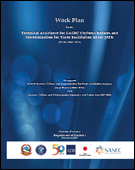 Work Plan for the Technical Assistance for SASEC Customs Reform and Modernization for Trade Facilitation under JFPRThis work plan serves as a roadmap to implement the second tranche policy actions of the SASEC Customs Reform and Modernization for Trade Facilitation Program, a policy-based loan signed between the Government of Nepal and the Asian Development Bank. Ten policy actions feature reform milestones in (i) policy and legal framework, (ii) automation, (iii) organization restructuring, and (iv) capacity development—building blocks to transform the Nepal Department of Customs into risk-based, paperless e-Customs operations, introduce customs procedures with economic impact to promote exports, and comply with WTO TFA measures and implement RKC general standards and other relevant international standards. This work plan comprises tasks designed to boost the capacity of the Customs and support delivery of its Customs Reform and Modernization Strategies and Action Plan 2017–2021. It also includes implementation arrangements, timeline, and inputs from the technical assistance (TA) attached to the Program. Author: Nepal Ministry of Finance, Department of Customs Year: 2017 Download Tags: SASEC, Customs, ADB, Nepal, Trade Facilitation Agreement Least Developed Countries Report 2017This report focuses on transformational energy access for the LDCs, where 62% of people have no access to electricity. It makes a case for trade in electricity, such as the 2014 South Asian Association for Regional Cooperation framework agreement for regional cooperation on electricity among Afghanistan, Bangladesh, Bhutan, India, Maldives, Nepal, Pakistan, and Sri Lanka. International and regional trade in electricity could help lower electricity prices, mitigate power shocks, relieve shortages, and facilitate the transition to cleaner energy. Author: United Nations Conference on Trade and Development Year: 2017 Download Tags: Bangladesh, Bhutan, Maldives, Nepal, Sri Lanka, Energy, Least Developed Countries, Trade SME Competitiveness Outlook 2017 – The Region: A Door to Global TradeThe most common form of trade for small and medium-sized enterprises (SMEs) is regional trade. This report shows that regional trade agreements deliver inclusive growth, attracting value chain activity and fostering competitiveness for small firms. It provides advice for policymakers, businesses, and trade and investment support institutions. The report also includes 50 country profiles—including those of Bangladesh, Bhutan, India, Nepal, and Sri Lanka—showing SME competitiveness and export potential by region. Author: International Trade Centre Year: 2017 Download Tags: Small and Medium Enterprise, Trade, Bangladesh, Bhutan, India, Nepal, Sri Lanka Regional Cooperation and Integration in Asia and the Pacific: Implementation of the Operational Plan for Regional Cooperation and Integration, 2016–2020─Corporate Progress Report 2017Regional cooperation and integration (RCI) is a valuable means for attaining national development goals. This report reviews ADB’s progress in implementing its Operational Plan for Regional Cooperation and Integration, 2016–2020, and identifies areas for improvement. It takes a close look at progress in connectivity, competitiveness, and regional public goods and collective action through projects such as the Nepal: SASEC Customs Reform and Modernization for Trade Facilitation Program. Author: Asian Development Bank Year: 2017 Download Tags: Nepal, Energy, Trade, Customs, Myanmar, Regional Cooperation, Regional Integration, SASEC, Trade Facilitation Customs Clearance Procedure for Relief Materials 2017 This relief consignment procedure published by the Nepal Department of Customs act as guide for the import of relief materials in response to emergencies and disaster situations in Nepal. It identifies items that can and cannot be imported, and conditions for import, and details procedures for Customs clearance, including declaration and valuation. It also discusses provisions for temporary import or export of relief goods. Author: Department of Customs, Ministry of Finance, Nepal Year: 2017 Download Tags: Customs, Nepal, Trade Facilitation, Temporary admission 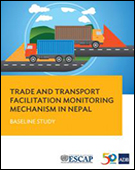 Trade and Transport Facilitation Monitoring Mechanism in NepalThis report synthesizes the business process analysis conducted on import of wool through Kolkata-Birgunj-Kathmandu, export of wool carpet from Kathmandu-Birgunj-Kolkata, and import of fabrics from Bangladesh to Nepal through Dhaka-Banglabandha-Fulbari-Panitanki-Kakarbhitta-Kathmandu. It also measures the performance of trade corridors and border crossings in Nepal, to quantify current trade and transport facilitation and provide recommendations. Findings of the study reveal bottlenecks to trade, including procedures needed to complete import/export, compounded by requirements for transiting trade through India, which further prolongs the trade process and increases the cost. The report includes specific short-term and long-term policies to improve Nepal’s trade and transport facilitation. Author: Asian Development Bank and United Nations Economic and Social Commission for Asia and the Pacific Year: 2017 Download Tags: Trade Facilitation, Nepal, Import, Export, ADB RCI Key Indicators for Asia and the Pacific 2017This report gives the latest statistics on economic, financial, environmental, and Sustainable Development Goal (SDG) indicators for the 48 regional members of the Asian Development Bank, including up-to-date figures on energy, trade, and transport. In 2016, Asia and the Pacific accounted for 40.9% of global gross domestic product (GDP). While foreign direct investment (FDI) flows declined in East Asia and Southeast Asia in 2016, FDI flows to South Asia remained stable. The average number of days required to start a business in South Asia was 16. Energy consumption is also expected to increase in the coming decades owing to increasing GDP per capita and an increase in the use of energy-consuming goods. Author: Asian Development Bank Year: 2017 Download Tags: ADB, Energy, Transport, Bangladesh, Bhutan, India, Maldives, Nepal, Southeast Asia, Sri Lanka Nepal Energy Sector Assessment, Strategy, and Road MapTo improve energy security and stimulate economic growth in the face of an unprecedented energy crisis, Nepal is accelerating the development of its hydropower sector. This report examines the performance of Nepal’s energy sector amid development constraints, and highlights government development plans and strategy. It assesses the Asian Development Bank’s (ADB’s) future support strategy, which sees Nepal’s energy sector as a key driver of inclusive economic growth. Author: Asian Development Bank Year: 2017 Download Tags: Energy, Nepal, SASEC, ADB, Hydropower Asian Development Outlook (ADO) Supplement: A Firmer Growth Outlook for AsiaGrowth forecast for developing Asia for 2018 is downgraded to 5.8%, from projections in the Asian Development Outlook 2017 Update in September 2017. Forecasts for the region’s inflation rates have been retained at 2.9% for 2018. For South Asia, growth outlook for 2018 is retained at 7.0%. India’s gross domestic product (GDP) growth rebounded to 6.3% in FY2017 (ending 31 March 2018), led by manufacturing. Bangladesh showed higher GDP growth for FY2017 (ended 30 June 2017) than was previously estimated. Bhutan showed stronger growth than forecast, supported by transport and communication services and construction. Growth projections for Maldives, Nepal, and Sri Lanka are in line with those in the Update. Author: Asian Development Bank Year: 2017 Download Tags: ADB, India, Bangladesh, Bhutan, Maldives, Nepal, Sri Lanka, Manufacturing Asian Development Bank and Nepal: Fact SheetThe ADB Fact Sheet provides social and economic indicators on Nepal, as well as information on ADB operations in the country and contact details. Nepal is working toward graduation to middle-income country status and achieving the Sustainable Development Goals by 2030. ADB assistance aims to improve equitable access to education while pursuing a strategy that aims to address bottlenecks in infrastructure development in energy, transport, and urban facilities. ADB operations will also focus on agriculture, gender equality, good governance, environmental sustainability, regional cooperation, and private sector development. Author: Asian Development Bank Year: 2017 Download Tags: ADB, Nepal, Sustainable Development Goals, Infrastructure, Energy, Transport, Agriculture, Regional Cooperation, Gender 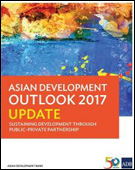 Asian Development Outlook (ADO) 2017 Update: Sustaining Development through Public-Private PartnershipDeveloping Asia is forecast to expand by 5.9% in 2017 and 5.8% in 2018, a slight upgrade from projections in the Asian Development Outlook 2017. However, growth forecast for South Asia is downgraded to 6.7% in 2017. India’s growth remains strong and most South Asian countries are expected to meet or exceed growth forecasts from April. Exceptions are Sri Lanka, where agriculture was affected by drought and floods, and Bhutan, where geological problems have constrained construction on two large hydropower projects. Growth in Nepal surged in 2017 on earthquake recovery but is slowing as agriculture struggles, following severe flooding in August 2017. Inflation forecast in South Asia is lowered to 4.2% for 2017 and 4.7% for 2018. Favorable global commodity prices, good harvests, and prudent macroeconomics are expected. Author: Asian Development Bank Year: 2017 Download Tags: Asia, Development, Sustainability, Public Private Partnerships, South Asia, India, Sri Lanka, Agriculture, Bhutan, Hydropower, Energy, Nepal 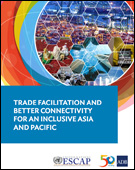 Trade Facilitation and Better Connectivity for an Inclusive Asia and PacificThis report investigates the evolution of trade costs, examines trade facilitation and paperless trade implementation, and highlights key initiatives in South Asia, including efforts by members of the South Asia Subregional Economic Cooperation (SASEC). The SASEC Trade Facilitation and Transport Working Group agreed to expand assistance to trade facilitation through technical assistance to support more efficient, transparent, secure, and service-oriented processing of cross-border trade across South Asia. Through 2025, the SASEC connectivity agenda will be better aligned with the frameworks of South Asian Association for Regional Cooperation and the Bengal Initiative for Multi-Sectoral Technical and Economic Cooperation. To help establish a trade and transport facilitation monitoring mechanism, Bangladesh, Bhutan, and Nepal conducted studies that reviewed trade and transport procedures, analyzed bottlenecks, and gave recommendations on trade and transport facilitation. Author: Asian Development Bank and United Nations Economic and Social Commission for Asia and the Pacific Year: 2017 Download Tags: ADB, Bangladesh, Bhutan, BIMSTEC, Maldives, Nepal, SAARC, India, Myanmar, SASEC, South Asia, Sri Lanka, Trade Facilitation, Transport, UNESCAP, ADB RCI 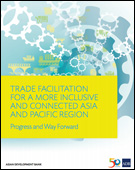 Trade Facilitation for a More Inclusive and Connected Asia and Pacific Region: Progress and Way ForwardThis report gives an overview of assessments from the 2017 global survey on trade facilitation and paperless trade in Asia and the Pacific. It looks at the implementation of trade facilitation and paperless trade measures in 44 countries in Asia and the Pacific, including how the South Asia Subregional Economic Cooperation Trade Facilitation Strategic Framework promotes development by deepening regional cooperation. The Framework covers national and subregional projects in Customs harmonization, improving cross-border facilities, and transport facilitation. The Framework also supports regulatory reforms and the development of the National Single Window Customs management system in Bangladesh, Bhutan, Maldives, and Nepal. Author: Asian Development Bank and United Nations Economic and Social Commission for Asia and the Pacific Year: 2017 Download Tags: ADB, Bangladesh, Bhutan, BIMSTEC, Maldives, Nepal, Regional Cooperation, Regional Integration, SAARC, SASEC, Standards Harmonization, Trade Facilitation, Trade Facilitation Agreement, WTO, UNESCAP, ADB RCI Together We Deliver: 50 Stories of ADB's Partnerships in Asia and the PacificThis special edition of Together We Deliver tells 50 stories that highlight the importance of good partnerships in Asia and the Pacific in meeting complex development challenges. In South Asia, ADB has supported infrastructure development and social programs, helping lift people out of poverty in a diverse, rapidly urbanizing subregion. The South Asia Subregional Economic Cooperation Roads Improvement Project, for instance, is set to widen 160 kilometers of Nepal’s East–West Highway, which connects Nepal to India. The improved roads will provide faster and better access to social services and economic opportunities, and will facilitate national and regional integration. Author: Asian Development Bank Year: 2017 Download Tags: ADB, Economic Corridor Development, India, Nepal, Regional Integration, Roads, SASEC, South Asia, Transport 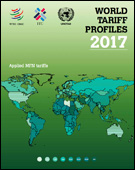 World Tariff Profiles 2017World Tariff Profiles is a joint publication of the World Trade Organization (WTO), International Trade Centre, and the United Nations Conference on Trade and Development devoted to information on market access for goods. It contains comprehensive data on tariffs and non-tariff measures imposed by over 170 countries and Customs territories. This year’s edition takes a close look at export diversification, analyzing to what extent economies have diversified their exports over time. Many countries make it a policy to diversify exports to obtain bigger market shares. An overview of export diversification shows how India, Myanmar, Sri Lanka, Bangladesh, and Bhutan have grown in the last two decades. Bangladesh in particular has achieved significant increase in terms of both product coverage and market reach. Author: World Trade Organization, International Trade Centre, and the United Nations Conference on Trade and Development Year: 2017 Download Tags: Bangladesh, Bhutan, Export, India, Maldives, Myanmar, Nepal, Sri Lanka, Tariffs, Trade, UNCTAD, WTO SARSO News: Vol. 31, No. 2The South Asian Regional Standards Organization (SARSO) newsletter features updates on SARSO events and activities. This issue features the publication of three South Asian Association for Regional Cooperation standards on food quality and safety, and the workshop on the importance of ISO 14001—which aims to help organizations improve environmental performance through the efficient use of resources and reduction of waste—and its impact on the environment and trade. It also has reports on Workshop on Conformity Standards held in New Delhi, India, and the Enhancing Capacity for Sanitary and Phytosanitary (SPS) Measures for Safe Trade in Animal and Animal Products in South Asia held in Kathmandu, Nepal. Author: South Asian Regional Standards Organization Year: 2017 Download Tags: Agriculture, Bangladesh, Bhutan, India, Nepal, SAARC, SARSO, South Asia, Standardization, Trade World Trade Statistical Review 2017The World Trade Statistical Review looks at the last 10 years and examines the latest developments in world trade, with a detailed analysis of the most recent trends for trade in goods and services. The book gives information on the participation of India, Bangladesh, and other South Asian economies in world trade, and highlights trends in the use of trade-facilitating measures. It also gives information on the implementation of the WTO Trade Facilitation Agreement and regional trade agreements, such as the South Asian Free Trade Arrangement. Author: World Trade Organization Year: 2017 Download Tags: Export, Least Developed Countries, Aid for Trade, SAFTA, South Asia, Trade Facilitation, WTO, Bangladesh, Bhutan, India, Maldives, Myanmar, Nepal, Sri Lanka Win-Win: How International Trade Can Help Meet the Sustainable Development GoalsThis book aims to demonstrate to policy makers how international trade can contribute to achieving the Sustainable Development Goals (SDGs). Trade can promote income growth, which can then support sustainable development. In addition, there are also direct links between trade and sustainable development, such as trade’s effect on the price and availability of health, education, energy, and other important services. This book maps out a triple-win scenario where good trade policy spurs international trade, contributes to development-friendly outcomes, and helps achieve the SDGs. Author: Matthias Helble and Ben Shepherd, eds. Year: 2017 Download Tags: Bangladesh, India, Maldives, Nepal, Services, South Asia, Sustainability, Sustainable Development Goals Trade and Transport Facilitation Monitoring Mechanism: Baseline Study in BangladeshThis report synthesizes the business process analysis conducted on the export of plastic kitchenware and tableware from Bangladesh to Bhutan through Burimari land port, and the import of lentils from Nepal to Bangladesh through Banglabandha land port, as well as studies on trade corridors and border crossings in Bangladesh, to quantify current trade and transport facilitation in Bangladesh through a set of indicators. Findings of the study reveal bottlenecks to trade, including costly one-time procedures for a new trader, numerous documents and copies required to complete export and import processes, and low speed along the trade corridors. This report includes specific short-term and long-term policies to improve Bangladesh’s trade and transport facilitation. Author: Asian Development Bank Year: 2017 Download Tags: Trade Facilitation, Transport, Bhutan, Bangladesh, Nepal, SASEC, ADB RCI Lessons from ADB Transport Projects: Moving Goods, Connecting People, and Disseminating KnowledgeThis publication shares 20 case stories from the Asian Development Bank bearing practical lessons for transport projects across Asia and the Pacific region under different socioeconomic and political situations. The book includes reports on improving aviation in Bhutan, working on computerized transport and trade logistics in Nepal, and constructing Sri Lanka's Greenfield Highway, and the role policy plays in those projects. It also draws lessons from how India's road development increased rural communities' access to public services and economic opportunities, and how participatory processes in selecting road improvement projects in Bangladesh provide a model for long-term plan for road maintenance. Author: Asian Development Bank Year: 2017 Download Tags: ADB, Bangladesh, Bhutan, India, Nepal, Railway, Sri Lanka, Transport, ADB RCI World Investment Report 2017This report presents foreign direct investment (FDI) trends and prospects at global, regional and national levels. FDI flows to developing Asia contracted by 15% to $443 billion in 2016. This decline was relatively widespread, except in South Asia, where several countries including Bangladesh and Nepal are expected to receive more FDI in the coming years. The report investigates the internationalization patterns of digital multinational enterprises, as well as the effect of digitalization on global companies across all industries. It provides insights to policymakers on how the digital economy impacts investment policies and how investment policy can support digital development, with a view toward achieving the SDGs. Author: United Nations Conference on Trade and Development Year: 2017 Download Tags: FDI, Global Value Chains, Investment, Policy, South Asia, UNCTAD, Bangladesh, India, Nepal Regional Cooperation for Sustainable Energy in Asia and the PacificCountries in the Asia-Pacific region face multiple energy-related challenges, which are driving transformation of energy systems. Addressing these energy challenges is an integral part of implementing the 2030 Agenda for Sustainable Development, including ensuring access to affordable, reliable, sustainable, and modern energy for all. This report analyzes challenges in the Asia-Pacific region and its efforts to accelerate the energy transition to achieve Sustainable Development Goal 7. Author: United Nations Economic and Social Commission for Asia and the Pacific Year: 2017 Download Tags: Asia-Pacific, Energy, Sustainability, Sustainable Development Goals, UNESCAP, Bangladesh, Bhutan, India, Maldives, Myanmar, Nepal, Sri Lanka Eradicating Poverty and Promoting Prosperity in a Changing Asia-PacificThis report explores five long-term trends in the Asia-Pacific region that will shape approaches to poverty alleviation and the prospects for achieving prosperity: regional economic cooperation and integration; rural–urban transitions; demographic changes; ICT access and connectivity; and demand for natural resources. It examines the changing development context in South Asian and other economies. It also looks at opportunities created by regional cooperation and integration that intend to bring about shared economic benefits. Author: United Nations Economic and Social Commission for Asia and the Pacific, Asian Development Bank, United Nations Development Programme Year: 2017 Download Tags: ADB, Connectivity, ICT, Regional Cooperation, Sustainability, UNESCAP, UNDP, Bangladesh, Bhutan, India, Maldives, Nepal, Sri Lanka 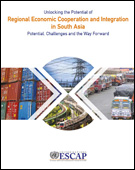 Unlocking the Potential of Regional Economic Cooperation and Integration in South AsiaAt a modest 6% of total trade, intraregional trade in South Asia stands at less than one third of its full potential. Trade barriers and inadequate infrastructure have cost South Asia over US $54 billion per year in lost export opportunities. With 309 million people living on less than $1.90 a day—the largest concentration of poverty in the world—South Asia should urgently pursue broad-based regional economic cooperation that could enable effective responses to the subregion’s developmental challenges. This report examines the state of economic integration in South Asia and identifies potential areas for further strengthening subregional linkages. It provides recommendations on policy actions to increase market integration, improve connectivity, boost investment in infrastructure development, and tackle shared vulnerabilities and risks. It calls for the consolidation and upgrading of existing trade and investment cooperation initiatives into a South Asia Comprehensive Economic Partnership. Author: United Nations Economic and Social Commission for Asia and the Pacific Year: 2017 Download Tags: BIMSTEC, Investment, Regional Cooperation, SAARC, South Asia, Sustainability, Sustainable Development, Trade, UNESCAP, Bangladesh, Bhutan, India, Maldives, Myanmar, Nepal, Sri Lanka Climbing Higher: toward a Middle-income NepalNepal is experiencing modest growth but brisk poverty reduction. It has halved the poverty rate in just seven years and witnessed an equally significant decline in income inequality. Yet Nepal remains one of the poorest and slowest-growing economies in Asia, with per capita income falling behind its regional neighbors. The report discusses the need for comprehensive policy reform to address the country’s challenges in becoming a lower-middle-income country by 2030. The report outlines suggested reforms to facilitate greater investment and improved productivity, build new sources of growth, and deepen human capital. Author: World Bank Group Year: 2017 Download Tags: Employment, Investment, Nepal, Poverty Reduction, Trade, Transport, WB 2016 Development Effectiveness ReviewThe Development Effectiveness Review tracks development progress in Asia and the Pacific and monitors the Asian Development Bank’s (ADB) effectiveness 2010-2016. For South Asia, ADB shares results in regional cooperation, energy, and road and rail transport. ADB also approved $4.4 billion in financing for projects in South Asia during 2016. The Review includes details of ongoing and newly approved projects. Author: Asian Development Bank Year: 2017 Download Tags: ADB, Asia-Pacific, Development, Poverty Reduction, Regional Cooperation, Regional Integration, Roads, Transport, Bangladesh, Bhutan, India, Maldives, Nepal, Sri Lanka The Little Data Book on Information and Communication TechnologyThis book presents quick indicators for more than 200 countries showing data on key indicators of information and communications technology (ICT), including access, quality, affordability, efficiency, sustainability, and applications. It includes data for Bangladesh, Bhutan, India, Maldives, Myanmar, Nepal, and Sri Lanka. Author: World Bank and International Telecommunications Union Year: 2017 Download Tags: Bangladesh, Bhutan, ICT, India, Maldives, Myanmar, Nepal, Sri Lanka, South Asia, WB 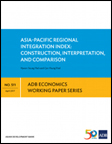 Asia-Pacific Regional Integration Index: Construction, Interpretation, and ComparisonDeeper regional integration expands markets, helps maximize the efficiency of resource allocation, and boosts productivity and investment opportunities, all serving stronger economies. This study proposes a regional integration index for Asia and the Pacific, the Asia-Pacific Regional Integration Index (APRII), comprising 26 indicators that measure various aspects of regional integration along six dimensions: trade and investment integration, money and finance integration, regional value chains, infrastructure and connectivity, free movement of people, and institutional and social integration. In the overall APRII, India ranks 14th—scoring closely to the Asia region integration average of 0.473—and scores highest on regional value chains and institutional and social integration. Nepal ranks 15th, scoring highest on regional value chains and trade and investment integration. Bangladesh and Sri Lanka rank 18th and 20th, respectively, and score highest on regional value chains. Maldives ranks 21st, scoring highest on free movement of people. Myanmar and Bhutan ranks 26th and 27th, and both score highest on trade and investment integration. In the overall regional integration indexes of selected Asian subregions, South Asia ranks 4th. Author: Hyeon-seung Huh, Cyn-Young Park Year: 2017 Download Tags: Regional Integration, Nepal, Bangladesh, Maldives, Myanmar, Bhutan Basic Statistics 2017Basic Statistics 2017 contains development indicators for 45 economies in the Asia and Pacific Region, including the seven SASEC countries, Bangladesh, Bhutan, India, Maldives, Myanmar, Nepal, and Sri Lanka. It includes selected indicators of the Sustainable Development Goals (SDGs) such as the proportion of population living below $1.90 (PPP) a day, proportion of population with access to electricity, renewable energy share in the total final energy consumption, unemployment rate, total official flows for infrastructure, and trade balance. Author: Asian Development Bank Year: 2017 Download Tags: Energy, Trade Facilitation, Transport, Sustainable Development Goals, Bangladesh, Bhutan, India, Maldives, Myanmar, Nepal, Sri Lanka Global Energy InterconnectionSustainable energy and climate change are major global concerns, yet three billion people around the world rely on wood, coal, or animal waste for cooking and heating. The interconnection of grids would open up opportunities for resource sharing and bring clean energy to much more of the world. This paper assesses benefits and outlines policy, technical, and economic preconditions for global energy interconnection. It analyzes global transmission scenarios and evaluates their impact on energy supplies and the environment. It also gives recommendations for setting standards, and where stakeholder involvement is necessary. Author: International Electrotechnical Commission Year: 2017 Download Tags: Energy, India, Nepal, Policy, Standardization, Sustainability, Trade, South Asia Implications of Brexit to the Asia-Pacific Region: with a Focus on Least Developed Countries (Trade Insights: Issue No. 20)This issue of Trade Insights, published by United Nations Economic and Social Commission for Asia and the Pacific, discusses how possible Brexit scenarios could adversely affect least developed countries in the Asia-Pacific region. Simulation results show that potential reduction in exports to the United Kingdom for fish, clothes, textiles, footwear, and other key items can range from 16% to 50% of their current export value. According to the study, countries heavily exposed to Brexit-induced risks must analyze the extent of such impact and engage the United Kingdom in discussions in order to limit negative impact. Author: Louis Graham, Arun Jacob, and Anders K. Møller Year: 2017 Download Tags: Asia-Pacific, Least Developed Countries, South Asia, Trade, UNESCAP, India, Bangladesh, Maldives, Myanmar, Nepal, Sri Lanka Asian Development Outlook 2017: Transcending the Middle-Income Challenge The Asian Development Outlook 2017 forecasts 5.7% growth for developing Asia in 2017 and 2018, and 7% and 7.2% for South Asia in 2017 and 2018. Resumption of growth in South Asia follows the brief slowdown in 2016 due to decline in fixed investment and impact of demonitization on trade and commerce. Growth in India is forecast at 7.4% in fiscal 2017 and 7.6% in 2018. In Bhutan, growth is expected to accelerate to 8.2% in 2017, with expanded investment in hydropower for export, and added capacity in electricity generation. Nepal's growth is expected to revive to 5.6% in 2017 with increased post-earthquake reconstruction and more reliable electricity. Author: Asian Development Bank Year: 2017 Download Tags: ADB, India, Bhutan, Nepal, South Asia Facilitate Trade for Development: Aid for Trade The Aid for Trade program has been providing support to developing economies in tackling obstacles to growth through better facilitation of trade in the last 10 years. Since its launch in 2006, a total of $308 billion has been disbursed to finance aid-for-trade programs and projects, which are working to reduce trade and transport costs, promote trade expansion, and achieve economic and social objectives. As high trade costs persist in keeping developing countries from fully exploiting their trade and development potential, the Aid for Trade program remains highly relevant, and will help developing economies, including landlocked and small and vulnerable economies, achieve the 2030 Agenda for Sustainable Development. Author: William Hynes and Frans Lammersen Year: 2017 Download Tags: Trade, Development, Aid for Trade, Trade Facilitation, Transport, Bangladesh, Bhutan, Myanmar, Nepal, Least Developed Countries 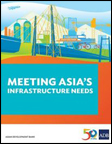 Meeting Asia's Infrastructure NeedsThis report estimates infrastructure investment needs in Asia and the Pacific for 2016-2030, updating the Asian Development Bank's assessment for 2010-2020 published in 2009. The report places developing Asia's investment needs at $26 trillion to maintain its growth momentum, eradicate poverty, and respond to climate change. While developing Asia's infrastructure, including its transport network and electricity generation capacity, has improved significantly over the years, it remains far from adequate – lack of reliable power supply continues to constrain economic growth and traffic congestion results in lost productivity, wasted fuel, and human stress. The report recommends $14.7 trillion investment for power and $8.4 trillion for transport. South Asia requires investments valued at 8.8% of gross domestic product. Author: Asian Development Bank Year: 2017 Download Tags: Asia, South Asia, Energy, Transport, Bangladesh, Bhutan, ADB, India, Maldives, Myanmar, Sri Lanka, Nepal 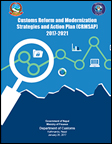 Customs Reform and Modernization Strategies and Action Plan 2017-2021The Customs Reform and Modernization Strategies and Action Plan 2017-2021 of the Nepal Department of Customs (DOC) aims to serve as a blueprint of Customs reform for the next four years, with a vision to support Nepal's initiatives toward economic and social prosperity. With Nepal seeing continuous increase of cross-border trade over the last decades, this Plan is being implemented to align Nepal toward international standards. It outlines the DOC's vision, mission, guiding principles, as well as strategies, such as expediting legitimate trade facilitation and enhancing Customs automation and data management, to create a conducive environment for seamless movement of cargo traffic to and from the borders, and help in lowering transaction costs through greater transport facilitation. Author: Nepal Department of Customs Year: 2017 Download Tags: Customs, Customs Valuation, Nepal, Trade Facilitation, Import, Export, Trade, Revised Kyoto Convention 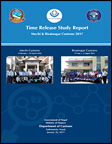 Time Release Study: Mechi and Biratnagar Customs 2017Time Release Study is a special tool developed by the World Customs Organization to measure effectiveness of operational procedures carried out by Customs, other regulatory agencies and private sector stakeholders in the standard processing of imports, exports, cross border and transit movements. A key activity identified in Nepal's Customs Reform and Modernization Strategies and Action Plan 2013-2017, it identifies the average time taken for clearance of consignments from entry to exit in the Customs area, enabling possible corrective measures to
improve performance. This Study was undertaken to support trade facilitation measures being introduced by the Nepal Department of Customs to reduce bottlenecks to faster Customs clearance, and promote seamless movement of cargo traffic to and from the Country. Author: Nepal Department of Customs TRS Working Group Year: 2017 Download Tags: Trade Facilitation, Time Release Study, Import, Export, Trade, Nepal, WCO Study for Development of a Potential Hydropower Plant in South AsiaRapid development in South Asia has produced a huge surge in energy demand. Nepal, with more than 83,000 megawatts of potential hydropower supply, can significantly increase the South Asian Association for Regional Cooperation (SAARC) region's energy security. This study highlights ongoing hydropower projects in Nepal, in particular, the Sunkoshi 2 Storage Project, which has the potential to become a regional hydropower plant in South Asia. It also emphasizes the need to expand the region's power transmission infrastructure to promote power trade, and updating of policies that govern cross-border electricity trade among countries in the region. Author: SAARC Energy Centre Year: 2016 Download Tags: Hydropower, Energy, Nepal, SAARC, Trade Economic Benefits from Nepal-India Electricity TradeThis report confirms Nepal and India's viable electricity export potential, and highlights how facilitating cross-border trade of electricity will benefit both countries. In Nepal, substantial economic gains can boost the economy and improve the well-being of its people—in 2045 under the accelerated power trade scenario, electricity trade revenue can bring in up to $9.8 billion. In India, gains from cross-border trade centers on lower electricity system cost—hydropower imports from Nepal will allow India to forgo some investment needed to meet its capacity demand. Furthermore, hydropower will complement India's solar and wind power generation, offering an affordable and convenient renewable resource to meet its evening peak demand. Author: South Asia Regional Initiative for Energy Integration Year: 2016 Download Tags: Energy, Trade, India, Nepal, Hydropower 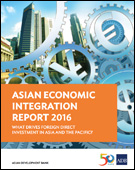 Asian Economic Integration Report 2016: What Drives Foreign Direct Investment in Asia and the Pacific?The 2016 Asian Economic Integration Report reviews regional economic cooperation and integration in Asia and the Pacific, amidst the rising global uncertainty following the United Kingdom’s referendum on leaving the European Union and the U.S. election, slower-than-expected global economic recovery, and ongoing economic restructuring in the People’s Republic of China and growth moderation. Asia faces heightened uncertainty–trade growth decelerated in 2015, falling to 2.3% in 2015; subregional trade linkages continue to strengthen, but inter-subregional trade linkages weakened; and non-tariff measures have become major obstacles to trade. In South Asia, SASEC cooperation has improved access to key markets in smaller economies, reduced real trade costs and behind-the-border barriers to stimulate investment; and enabled cross-border power exchanges to ensure power supply affordability, reliability, and overall grid stability. However, the SASEC agenda needs to be framed within wider integration processes taking place in Asia in the next decade to enhance economic linkages, and harness the full potential of Asian integration. Author: Asian Development Bank Year: 2016 Download Tags: ADB, ASEAN, Asia-Pacific, Development, FDI, Free Trade Agreements, Regional Cooperation, Regional Integration, SASEC, Trade Facilitation, UNCTAD, Bangladesh, Bhutan, India, Maldives, Nepal, Sri Lanka SME Competitiveness Outlook: Meeting the Standard for TradeStandards and regulations for goods and services are important to international trade and value chains. They ensure consumer protection, determine compatibility, and promote environmental sustainability. This SME Competitiveness Outlook focuses on helping small and medium-sized enterprises (SME) make the most of standards and regulations to increase their competitiveness. Findings include strategies for SME managers on selecting and implementing standards and regulations, and an action plan for policymakers and trade and investment support institutions involved in aiding SMEs compete in markets where standards and regulations matter. Author: International Trade Centre Year: 2016 Download Tags: Trade, Small and Medium Enterprises, Bangladesh, India, Nepal, Sri Lanka, WTO, Global Value Chains 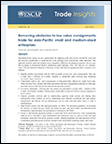 Removing Obstacles to Low Value Consignments (Trade Insights: Issue No. 18)Diffusion of digital technology and digitalization of products and services are allowing developing country small and medium-sized enterprises (SMEs)—which generate the majority of employment, especially in landlocked developing countries such as Nepal—to become globally competitive and participate in international trade. However, several barriers continue to hinder developing country SMEs to maximize benefits of cross-border digital trade. This publication recommends critical actions, including raising de-minimis thresholds; reducing Customs document requirements; developing low-cost and efficient transportation, delivery services, telecommunications and broadband networks; and establishing a legal framework that enhances conduct of online transactions. Additionally, neighbors in the region must coordinate and work together to build the required infrastructure, and to allow for mutual recognition or harmonization of systems, procedures, enforcement mechanisms and laws affecting digital trade. Author: Pascale Bourquin and Adam Heal Year: 2016 Download Tags: Small and Medium Enterprise, Nepal, ICT, Customs, Trade Facilitation 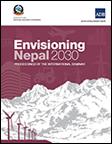 Envisioning Nepal 2030Nepal's National Planning Commission has undertaken the initiative to develop Nepal’s long term Development Strategy 2030 by engaging with international development experts, development partners, policy makers, and representatives of civil society organizations in the international seminar 'Envisioning Nepal 2030'. With the aim of serving as a guideline for Nepal’s graduation from Least Developed Country status by 2022, achieve the Sustainable Development Goals in the post-Millennium Development Goals era, and become a middle-income country by 2030, the seminar identified challenges and opportunities, and discussed how a fast-paced and sustainable inclusive growth could be achieved. In his opening remarks, Asian Development Bank Vice President Wencai Zhang, underscored the importance for Nepal to strategically position itself within a broader regional cooperation to transform itself from a landlocked into a landlinked country. Author: Nepal National Planning Commission Year: 2016 Download Tags: Nepal, Hydropower, Energy, Regional Cooperation Nepal Investment Guide 2016Nepal Investment Guide 2016 was published to provide information about investment opportunities in Nepal and the process of doing business. It identifies potential sectors for investment; relevant government agencies for foreign businesses; existing laws on labor, taxation, and imports and exports; special economic zones; and comparative benefits to investors. Author: Nepal Office of the Investment Board Year: 2016 Download Tags: Nepal, Import, Export, Investment 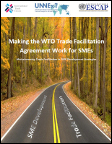 Making the WTO Trade Facilitation Agreement Work for SMEsSmall and Medium Enterprises (SMEs) comprise 95% of enterprises worldwide and provides at least two thirds of private sector employment. However, when it comes to international trade, SMEs experience limited capacity in dealing with the complex administrative and regulatory procedures associated with moving and selling goods across borders. This book fills a gap by providing a reference for articles of the World Trade Organization (WTO) Trade Facilitation Agreement (TFA) that are particularly beneficial to SMEs, and identifies examples of SME-specific programs, measures and interventions that can support the implementation of such provisions. It proposes mainstreaming relevant elements of the WTO TFA in existing SME policies and initiatives, to ensure that it contributes toward internationalization of SMEs.
Author: UNESCAP, UNNExT, and ITC Year: 2016 Download Tags: Small and Medium Enterprise, Trade Facilitation, Trade, UNESCAP, Small and Medium Enterprises, India, Nepal 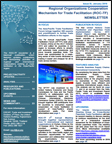 Regional Organizations Cooperation Mechanism for Trade Facilitation, Issue IX, January 2016This biannual publication features updates, publications and forthcoming activities of regional and international organizations working on trade facilitation in the Asia-Pacific region, including the Asian Development Bank (ADB), the World Customs Organization (WCO), and the United Nations Economic and Social Commission for Asia and the Pacific. It includes highlights of the Asia Pacific Trade Facilitation Forum 2015 and the Train-the-Trainer Workshops on Customs Valuation through Post Clearance Audit being jointly implemented by the WCO and ADB in the 6 SASEC member countries. This issue also features an analysis on achieving seamless supply chains through implementing comprehensive and pragmatic national trade facilitation reform programs. Author: UNESCAP Year: 2016 Download Tags: Trade Facilitation, Asia-Pacific, WCO, ADB, UNESCAP, Customs Valuation, Nepal, Bangladesh, Bhutan, India, Maldives, Sri Lanka Disentangling Transit Costs and Time in South AsiaLandlocked least developed countries are often hugely disadvantaged from a lack of effective transit options, which raise transportation costs and decrease their effective participation in international trade. This study examines trade barriers that impede the trade flow of Bhutan and Nepal through India's gateway ports of Haldia and Kolkata, under the overarching research theme of the impact of regional infrastructure for trade facilitation on growth and poverty reduction. It analyzes the impact of transit regulations and agreements on the cost of services required to transit goods between the ports and Bhutan or Nepal, to identify how the two landlocked countries are affected by the cost of transit services, which trade costs vary most significantly, and how firms are affected by the cost of transit services. Author: Prabir De, editor Year: 2015 Download Tags: Trade Facilitation, Transport Facilitation, Bhutan, Nepal Asian Development Outlook 2015 Supplement: Growth Holds Its Own in Developing AsiaThis Supplement maintains growth forecast for developing Asia at 5.8% in 2015 and 6.0% in 2016. In South Asia, economic outlook remains optimistic, with the region on track to meet Update projections of 6.9% in 2015 and 7.3% in 2016. India's economic expansion balances a slowdown in Bhutan—owing to weaker sales of hydropower—and the Maldives in 2015, and in Nepal in 2016—due to unfavorable weather and unforeseen delays in earthquake-related reconstruction. Growth projections for Bangladesh and Sri Lanka remain in line with those in the Asian Development Outlook Update. Author: Asian Development Bank Year: 2015 Download Tags: ADB, South Asia, Bangladesh, Bhutan, India, Maldives, Nepal, Sri Lanka World Trade Organization Annual Report 2015The World Trade Organization (WTO) Annual Report 2015 provides an overview of WTO activities in 2014 and early 2015. It presents a timeline of two decades of the WTO -- from its origins succeeding the General Agreement on Tariffs and Trade to its current role in the multilateral trading system. It presents a chapter on how WTO helps developing countries build trade capacity and allows them to implement trade agreements. WTO training courses are organized for officials from developing countries each year. Author: World Trade Organization Year: 2015 Download Tags: Trade, Trade Policy, WTO, Tariffs, Energy, Bangladesh, India, Nepal, Sri Lanka, Trade Facilitation, Transport, Asia, Agriculture Cross-Border Electricity Cooperation in South AsiaStrengthening cross-border electricity cooperation in South Asia can be part of the solution for providing adequate and reliable electricity. This World Bank Policy Research Working Paper reviews the status of cross-border electricity cooperation in South Asia, identifies key regional-level barriers to expand cross-border cooperation and trade in South Asia, and discusses the extent to which current domestic sector policies impede greater cross-border electricity cooperation. Finally, the findings offer policy recommendations on increased cross-border trade and cooperation. Author: Anoop Singh, Tooraj Jamasb, Rabindra Nepal, and Michael Toman Year: 2015 Download Tags: Energy, Regional Cooperation, Regional Trade, Bangladesh, Bhutan, India, Maldives, Nepal, South Asia, Sri Lanka, Trade, Trade Policy, WB 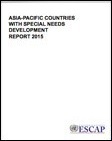 Asia-Pacific Countries with Special Needs Development Report 2015In the Asia-Pacific region, 36 out of the 58 economies are considered countries with special needs (CSN), which include least developed countries (LDC), landlocked developing countries, and small island developing States. This report highlights important areas that should be addressed as key priorities by CSNs such as economic diversification, external trade, South-South cooperation, and official development assistance including foreign direct investment. Bhutan and Nepal met the criteria for graduation from LDC status as of 2013. Other countries such as Bangladesh have a good chance of meeting the graduation criteria by 2018. Among the Small island developing States, Maldives is considered a success story in broadband internet connectivity. The results of this research show that Asia-Pacific CSNs must choose their paths to diversification carefully, depending on country circumstances. Author: United Nations Economic and Social Commission for Asia and the Pacific Year: 2015 Download Tags: Asia-Pacific, Least Developed Countries, Small Island Developing States, Bangladesh, Bhutan, Energy, FDI, Investment, Maldives, Nepal, Trade, Transport, UNESCAP Together We Deliver 2014: From Knowledge and Partnerships to ResultsThis book includes stories from Bangladesh, India, and Nepal, introducing how ADB has changed people’s lives for the better. It illustrates the innovation and partnerships needed to meet the evolving challenges in Asia and the Pacific. In Bangladesh and India, two ADB projects introduced new approaches in urban governance and development that improved the living conditions of the poor in congested areas. In Nepal, women and other disadvantaged groups were included in the planning of a water and sanitation project that benefited 90,000 households. The 12 uplifting stories in this publication show how partnerships are essential for developing pragmatic solutions to problems, testing and refining approaches, and creating reliable models to scale up benefits for a wider base. Author: Asian Development Bank Year: 2015 Download Tags: Bangladesh, India, Nepal 25 Years on the Ground: ADB-Nepal Partnership for Inclusive DevelopmentThis publication commemorates 25 years of Nepal Resident Mission’s opening and provides an overview of the Asian Development Bank’s (ADB) operation in Nepal over the years. It highlights ADB-assisted projects and Nepal’s association with the South Asia Subregional Economic Cooperation (SASEC) initiative, to further enhance the nation’s role in regional and world trade. These projects aim for regional energy cooperation (SASEC Power System Expansion Project), as well as subregional cooperation and connectivity in the transport sector (SASEC Road Connectivity Project and Subregional Transport Facilitation Project). Author: Asian Development Bank Year: 2015 Download Tags: Nepal, Transport, Energy, ADB RCI Nepali-language Version of Revised Kyoto ConventionThe Revised Kyoto Convention is a blueprint for Customs reform, and the Nepali-language version will assist Nepal’s Department of Customs to align its Customs Act and associated regulations with RKC standards, enhance efficiency and effectiveness of the Customs administration, and facilitate trade through more transparent Customs procedures. The standards of the RKC in the General Annex and Specific Annexes include duty collection, Customs control, information technology usage, and Customs clearance, among others. Author: World Customs Organization Year: 2015 Download Tags: Nepal, WCO, Customs 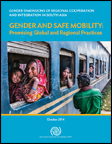 Gender Dimensions of Regional Cooperation in South Asia: Gender and Safe Mobility – Promising Global and Regional PracticesThis technical report analyzes global practices related to gender equality and safe migration, and their applicability to the context of South Asia. "Hard" aspects, such as physical infrastructure and equipment including border infrastructure, passenger holding facilities and surveillance cameras, and "soft" aspects, such as regional, bilateral and/or country-specific policies, programs, mechanisms and institutional linkages of safe mobility, are presented. The report also presents national policies and procedures that promote safe mobility. Given the lessons drawn from the reviewed policies and practices, it highlights the need for stronger evidence-based approaches in understanding the complex experience of women migrant workers, and identifies the need for more regular peer exchange through periodic regional dialogues of key stakeholder groups. Author: International Organization for Migration Year: 2014 Download Tags: Gender, Migration, South Asia, Bangladesh, Bhutan, India, Nepal, Transport, Trade 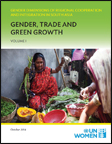 Gender Dimensions of Regional Cooperation in South Asia: Gender, Trade and Green Growth (Volumes I and II)This technical report presents an analysis of the interconnection between gender equality, regional trade and sustainable development in selected areas of four South Asian countries. In general, the report found women's contributions to total exports of all countries to be low, and in green exports to be lower. It identifies constraints and challenges, such as limited training in entrepreneurship, gender stereotypes related to green trade, existing gaps in policy framework, and weak access to technology, hindering women's participation in three green trade industries - agriculture and agro-processing, renewable energy, and ecotourism. The report looks at possible entry points for women, and recommended a list of actions to tap these identified entry points, including the need for greater exchange and cross-fertilization of experience among associations of women entrepreneurs and women’s chambers of commerce in South Asia. Author: Shreyasi Jha, Ritu Dewan, Amee Misra, Saloni Singh, Navanita Sinha, Maheen Sultan and Sonam Tobgay Year: 2014 Download Tags: Gender, Trade, Sustainability, South Asia, Bangladesh, Bhutan, India, Nepal 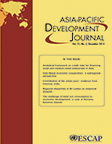 Asia-Pacific Development Journal Vol. 21, No. 2, December 2014The paper "Indo-Nepal Economic Cooperation: A Subregional Perspective" published in this issue of the Asia-Pacific Development Journal (APDJ) explores how subregional engagement among bordering regions can stimulate economic cooperation among countries in South Asia. It assesses the current status and potential of greater integration between India and Nepal, and develops a SWOT (strength-weakness-opportunity-threat) analysis reflecting on the need for a subregional approach to promotion of regional cooperation. APDJ, published twice a year by the Macroeconomic Policy and Development Division of UNESCAP, provides a platform for exchange of knowledge, experience, ideas, information and data on all aspects of economic and social development issues and concerns facing the region. Author: United Nations Economic and Social Commission for Asia and the Pacific Year: 2014 Download Tags: Economic Integration, India, Nepal, Trade, Bangladesh, Sri Lanka, Transport, Trade, Tourism World Tariff Profiles 2014This statistical yearbook devoted to market access for goods contains a comprehensive compilation of tariff parameters for each of the 160 World Trade Organization members, plus a number of other countries and customs territories where data is available. Each country profile presents information on tariffs
imposed by each economy on its imports, including an analysis of market access conditions in its major export markets. Statistics for all countries allow easy comparisons between countries and sectors, as well as between bound and applied tariffs. Author: World Trade Organization, International Trade Centre, and United Nations Conference on Trade and Development Year: 2014 Download Tags: WTO, Customs, Tariff, Bangladesh, India, Maldives, Nepal, Sri Lanka, Transport, Tariffs, Trade SME Competitiveness and Aid for Trade: Connecting Developing Country SMEs to Global Value ChainsThis joint ITC-WTO study discusses constraints faced by small and medium-sized enterprises (SMEs) in international trade, particularly by least developed countries. It reviews how Aid for Trade addresses these challenges through a sample of 23 Diagnostic Trade Integration Studies. Three bottlenecks emerge – quality of business environment, access to finance, and lack of institutional support to overcome trade-related challenges. This study also highlights actions taken by companies to integrate SMEs into their supply chains and concludes with an analysis of recent private sector program evaluations. Author: International Trade Centre and World Trade Organization Year: 2014 Download Tags: SME, Trade, Private Sector, Small and Medium Enterprises, Bhutan, India, Nepal, Sri Lanka, Sustainability National Trade Facilitation Bodies in the World This UNCTAD publication provides the first, in-depth quantitative analysis of 50 existing national trade facilitation bodies and a first-hand set of recommendations from experiences of participating stakeholders. It offers policy-oriented conclusions to assist countries about to set up or strengthen their national trade facilitation working groups. The study reveals that the biggest challenge for trade facilitation working groups is sustainability. Its determining elements include the administrative culture of each country, level of development, or type of body and geographical region. Author: United Nations Conference on Trade and Development Year: 2014 Download Tags: Trade Facilitation, Trade Policy, Sustainability, UNCTAD, Bangladesh, Bhutan, Nepal, Sri Lanka A World Trade Organization for the 21st Century: The Asian PerspectiveThis Asian Development Bank Institute book examines key changes in the world trading system and explores policy implications for Asia. Through a compilation of essays from prominent international and Asian trade experts, this book presents interaction of market forces and trade regulation. Lessons from the Asian experience offer new approaches and economic policies to sustain growth, presenting the World Trade Organization as a forum to improve regional and global trade governance in the 21st century. Author: Richard E. Baldwin, Masahiro Kawai, Ganeshan Wignaraja (Eds.) Year: 2014 Download Tags: Trade, Trade Policy, WTO, Bangladesh, Bhutan, Energy, India, Maldives, Nepal, Sri Lanka, Transport Regional Transit Agreement in South Asia: An Empirical InvestigationThis discussion paper published by the South Asia Watch on Trade, Economics and Environment assesses the potential gains of a sub-regional transit arrangement and the removal of other border-trade barriers, particularly the eastern South Asia sub-region (Bangladesh, Bhutan, India and Nepal). It also discusses the link between transit and trade flows, provides profiles of intra-regional transit trade and current transit arrangements in South Asia, and identifies efficient regional transit corridors using linear programming or the Data Envelopment Analysis model. Author: Prabir De and Arvind Kumar Year: 2014 Download Tags: South Asia, Trade, Transport, Economics, Economic Corridor, SASEC, SAARC, UNESCAP, Customs, Harmonisation, Bangladesh, Bhutan, India, Nepal, Maldives, Sri Lanka 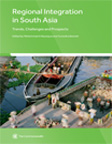 Regional Integration in South Asia: Trends, Challenges and ProspectsThis study presents an assessment of trade and economic cooperation among South Asian nations, explores emerging challenges, and highlights policy issues to foster regional integration. It provides perspectives on potential new areas of cooperation such as investment, regional supply chains, energy, and cross border transport networks. The four areas of focus are: potential gains from South Asian regional integration, key areas for cooperation resulting in effective regional integration, country perspectives of regional cooperation, and case studies on bilateral cooperation. This volume aims to further contribute to policy discourse on effective regional cooperation with perspectives from Bangladesh, India, Maldives, Nepal, Pakistan, and Sri Lanka.
Author: Mohammad A. Razzaque, Yurendra Basnett (Eds.) Year: 2014 Download Tags: South Asia, Regional Integration, Regional Cooperation, Bangladesh, India, Maldives, Nepal, Sri Lanka, Energy Statistical Yearbook for Asia and the Pacific 2014The Statistical Yearbook contains comparative statistics and facts about the 58 regional members and associate members of the Economic and Social Commission for Asia and the Pacific. It includes brief analyses of 32 key development features such as energy supply and use, international trade, and transport, among others. In energy, the region’s production structure is highly resource-intensive, although per capita energy use is low. The section on international trade recommends focusing on raising domestic value-added rather than increasing gross exports in Asia and the Pacific. Finally, investment in environmentally sustainable transport is encouraged. Author: United Nations Economic and Social Commission for Asia and the Pacific Year: 2014 Download Tags: Asia-Pacific, Energy, Trade, Transport, Bangladesh, Bhutan, India, Maldives, Nepal, Sri Lanka NTMs in South Asia: Assessment and AnalysisThe study “NTMs in South Asia: Assessment and Analysis” analyzes how Non-tariff Measures (NTMs) give rise to non-tariff barriers, which are becoming increasingly crucial for advancing trade cooperation among member countries of the South Asian Association for Regional Cooperation, yet remain less-addressed. The study examines export potential and actual export of South Asian countries, and attempts to highlight gains from reduction in transaction costs in bilateral trade. It also notes that initiatives for trade facilitation reforms in South Asia at the regional level remain low in incentives and have yet to produce significant results. The study closes with several recommendations for reducing and eliminating NTMs. Author: Selim Raihan, Mostafa Abid Khan, and Shaquib Quoreshi Year: 2014 Download Tags: Trade Facilitation, Trade, SAARC, Bangladesh, Bhutan, India, Maldives, Nepal, South Asia, Sri Lanka 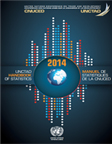 UNCTAD Handbook of Statistics 2014The UNCTAD Handbook of Statistics is a collection of statistics and indicators relevant to the analysis of international trade, investment and development. The 2014 edition shows the increasing convergence of trade balance between developing and developed economies continues. The report also includes regional trade data from South Asia that shows average annual growth rate of international trade improved from a previous deficit of -7.1% in 2012 to -0.1% in 2013. However, trade balance ran a deficit of -26.51% compared to the previous year's -25.94%. Trade indicators also report intra-trade in South Asian Association for Regional Cooperation region rose modestly from US$ 20,219 million to US$ 23,181 million between 2012 to 2013 and maintains intra-regional trade percentage at 5.8%. Author: United Nations Conference on Trade and Development Year: 2014 Download Tags: UNCTAD, Regional Trade, Development, Bangladesh, Bhutan, India, Maldives, Nepal, Sri Lanka, Transport 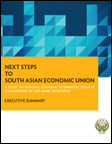 Next Steps to South Asian Economic UnionThis executive summary focuses on Phase II of the study on Regional Economic Integration, commissioned by the South Asian Association for Regional Cooperation (SAARC) Secretariat with the technical and financial assistance of the Asian Development Bank, and outlines a roadmap toward a South Asian Economic Union (SAEU). It presents an overview of intra-regional trade in South Asia—with India accounting for 65% of the region's combined total exports, and Sri Lanka 24% of total intra-regional imports—and discusses specific priority steps, using a phased and planned approach that quantifies potential gains from priority sectors identified in Phase I, needed to achieve regional economic integration. Thus, while non-tariff barriers, infrastructure constraints and other factors continue to challenge regional cooperation and integration in South Asia, reference by SAARC leaders toward an SAEU indicates a willingness to consider bold action. Author: Asian Development Bank Year: 2014 Download Tags: SAARC, South Asian Economic Union, Economic Integration, Bangladesh, Bhutan, India, Maldives, Nepal, Sri Lanka, Regional Integration Bridging Transport, ICT, and Energy Infrastructure Gaps for Seamless Regional ConnectivityThis publication is a contribution by the United Nations Economic and Social Commission for Asia and the Pacific to deliberations at the Second United Nations Conference on Landlocked Developing Countries (LLDCs) in Vienna, Austria, 3-5 November 2014. It shows regional connectivity as an unfinished agenda and bridging infrastructure gaps as a complex challenge for LLDCs. While physical infrastructure is a priority, this report argues that deeper regional integration – through regionally cohesive and terrestrial networks – is key to effectively linking Asian LLDCs to the region’s infrastructure networks. Author: United Nations Economic and Social Commission for Asia and the Pacific Year: 2014 Download Tags: Transport, ICT, Energy, UNESCAP, SASEC, Connectivity, Infrastructure, Bangladesh, India, Nepal, Sri Lanka, Trade, Trade Facilitation, Policy, Trade Policy Asian Economic Integration Monitor: November 2014This AEIM review of recent economic performance highlights the need for Asia to rebalance its sources of growth toward domestic and regional demand. It also shows a resilient Asia with rising GDP growth in South Asia. This issue includes a Special Chapter: Regional Financial Integration and Crisis in Asia and Europe – A Comparative Analysis. It presents Asia’s future path of integration as different from that in Europe. Asia will continue to strengthen efforts to harmonize rules and regulations in the financial sector and further unilateral trade and investment, while Europe is more likely to strengthen regional institutions to ensure recovery and better the monetary union. Author: Asian Development Bank Year: 2014 Download Tags: Asia-Pacific, Economic Integration, Europe, ASEAN, Bangladesh, Bhutan, India, Maldives, Nepal, Regional Integration, Sri Lanka, Trade Facilitation, Transport 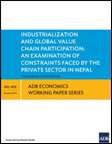 Industrialization and Global Value Chain Participation: An Examination of Constraints Faced by the Private Sector in NepalThis paper examines the constraints behind and beyond Nepal's borders that hinder its full participation in global value chains (GVC). Basing the analysis on recent and relevant publications, key economic data, and interviews with policymakers and stakeholders, the authors explain how weak and uncertain industrial policy has led to de-industrialization. They also looked at the effects of inadequate infrastructure, energy shortage, and inefficient transit. Failures in coordination, shallow regional integration and non-tariff barriers also bar further growth of Nepal's industrial development and GVC participation. The authors recommend necessary domestic reforms for behind-the-border constraints, and subregional partnerships—facilitated through the South Asia Subregional Economic Cooperation program—for beyond-the-border challenges. Author: Yurendra Basnett and Posh Raj Pandey Year: 2014 Download Tags: Infrastructure, Private Sector, Nepal, Global Value Chains, Industrialization, Infrastructure, Energy, Transport, Regional Integration, SASEC SASEC Website BrochureThis promotional brochure for the SASEC website features the web portal as a one-stop shop for information on SASEC activities, events, projects, and knowledge materials. The SASEC website seeks to build a dynamic discussion platform and repository of data on regional cooperation. Author: Asian Development Bank Year: 2014 Download Tags: SASEC, Knowledge Product, ICT, ADB, Bangladesh, Bhutan, India, Maldives, Nepal, South Asia, Transport, Trade Facilitation, Energy SASEC BrochureThis promotional brochure is a concise introduction to the South Asia Subregional Economic Cooperation (SASEC) Program, highlighting the main areas of regional cooperation and activity. It includes facts and figures about SASEC projects in transport, trade facilitation, energy, and ICT. Author: Asian Development Bank Year: 2014 Download Tags: SASEC, Trade Facilitation, Regional Cooperation, ICT, ADB, Bangladesh, Bhutan, India, Nepal, Maldives, Sri Lanka, Energy, Transport, Connectivity, Myanmar 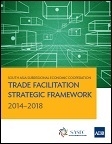 SASEC Trade Facilitation Strategic Framework 2014-2018The South Asia Subregional Economic Cooperation (SASEC) Trade Facilitation Strategic Framework 2014-2018 builds on the momentum of member countries over recent years in forging ahead with many significant improvements to facilitate, and ultimately increase, trade in the subregion and with the rest of the world. It supports the mission of the SASEC Transport and Trade Facilitation Strategy “to promote the prosperity of the subregion by facilitating the efficient movement of trade across the borders”, and focuses on five priority areas: customs modernization and harmonization; standards and conformity assessment strengthening; cross-border facilities improvement; through-transport facilitation; and institution and capacity building. Author: Asian Development Bank Year: 2014 Download Tags: SASEC, Trade Facilitation, Regional Cooperation, Transport, Trade, Customs, Standards, Harmonisation, Regional Integration, ADB, Bangladesh, Bhutan, India, Maldives, Nepal, Sri Lanka, South Asia, ADB RCI World Trade Report 2014 – Trade and Development: Recent Trends and the Role of the WTOThis annual publication highlights the relationship between trade and development, including changes since the start of the millennium. It identifies four key trends that altered the way trade affects development outcomes – accelerated economic growth in developing countries, expansion of global value chains, increase in agricultural and natural resource prices, and global nature of macroeconomic shocks. This report also explores how these trends have reshaped the role of trade in facilitating development and how recent development gains allow developing countries to adapt and mitigate risks. Author: World Trade Organization Year: 2014 Download Tags: WTO, Global Value Chains, Trade, Economic Growth, Agriculture, Trade Facilitation, Development, Bangladesh, Bhutan, India, Maldives, Nepal, South Asia, Sri Lanka South Asia Economic Focus: The Export OpportunityThis bi-annual report presents the recent economic developments, outlook, and policy of the following South Asian countries – Afghanistan, Bangladesh, Bhutan, India, the Maldives, Nepal, Pakistan, and Sri Lanka. It highlights developing country growth as fairly robust. Meanwhile, India’s growth rate is slowly increasing and its inflation rate declining. South Asian economies solidified their external positions by easing pressures to finance current account deficits, yet face domestic challenges such as reducing fiscal risks, supporting higher levels of investment, and sustaining export growth. Author: The World Bank Year: 2014 Download Tags: South Asia, Trade, Economics, WB, Bangladesh, Bhutan, India, Maldives, Nepal, Sri Lanka 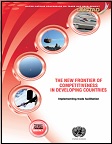 The New Frontier of Competitiveness in Developing Countries: Implementing Trade FacilitationThis report presents an overview of implementation challenges for realizing trade facilitation reforms. It consolidates results of 26 national trade facilitation implementation plans in 26 countries, comprising least developed countries, middle-income developing countries, landlocked countries, and small island economies in Africa, Asia, the Caribbean and Latin America. In the 26 countries surveyed, the level of implementation of trade facilitation measures in the World Trade Organization (WTO) is considerably lower in least developed countries (LDCs) than in developing countries. Since trade facilitation still remains a major challenge for developing countries and LDCs, an international legal regime with special and differential treatment will help developing WTO members achieve further progress. Author: United Nations Conference on Trade and Development Year: 2014 Download Tags: Trade Facilitation, Asia-Pacific, WTO, Bangladesh, Bhutan, Nepal 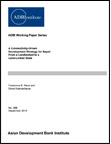 A Connectivity-Driven Development Strategy for Nepal: From a Landlocked to a Land-Linked StateTransforming Nepal from a landlocked into a land-linked state, the authors argue, could be key to unlocking the country's much-awaited growth. With its strategic location between India and the People's Republic of China, a connectivity-driven development strategy could energize Nepal's lackluster post-conflict economic performance. Further, Nepal implements a multi-track approach to promoting regional cooperation and integration in connectivity with its neighbors, reinforced through participation in South Asian Association for Regional Cooperation, Bay of Bengal Initiative for Multi-Sectoral Technical and Economic Cooperation, and South Asia Subregional Economic Cooperation. By identifying ten priority projects that could further boost Nepal's connectivity, the paper also discusses how strengthening Nepal's transport, energy, and trade links could benefit the region. However, the authors also warn against “internal threats” to Nepal's development—corruption and the country's difficult political situation. Author: Pradumna B. Rana and Binod Karmacharya Year: 2014 Download Tags: Nepal, Economic Corridor, Regional Trade, Connectivity, Development, Economic Growth, SASEC, India, Regional Cooperation, Regional Integration, SAARC, BIMSTEC, Transport, Energy, Trade 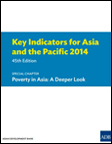 Key Indicators for Asia and the Pacific 2014This year's edition presents an in-depth inquiry on poverty in Asia, tackling whether the $1.25/day extreme poverty standard still accurately depicts minimum living standard of the poor in Asia and the Pacific. Using this broad measure, the poverty rate is projected to fall to 24.5% for South Asia by 2030, if recent economic growth trends continue. However, considering the current national poverty line average among today's less developed economies in the region, an Asia-specific extreme poverty line is more accurately estimated at $1.51/day, increasing Asia’s poverty rate in 2010 by 9.8%, and ��of a large economy like India by 15%. Hence, despite huge gains made, reducing poverty remains a pressing challenge in Asia and the Pacific. This book proposes several measures to counteract worsening poverty, including �close �regional cooperation which can reduce a country’s vulnerability, and urgent policy actions that promote economic growth and prioritize climate change adaptation and mitigation. Author: Asian Development Bank Year: 2014 Download Tags: Poverty Reduction, Disaster Risk, Regional Cooperation, Asia-Pacific, Bangladesh, Bhutan, Economics, Energy, India, Maldives, Milennium Development Goals, Nepal, Sri Lanka, Sustainability, Transport Assessing the Costs of Climate Change and Adaptation in South AsiaThis book discusses the economic costs and benefits of unilateral and regional actors on climate change adaptation in Bangladesh, Bhutan, India, the Maldives, Nepal, and Sri Lanka. It provides the total economic loss throughout the 21st century and estimates the funding required for adaptation measures to avert potential losses. Huge impacts are likely on vulnerable sectors in the region, with South Asia losing on average nearly 2% of its gross domestic product by 2050. Results of the study will aid climate change adaptation in the region, including initiatives for regional cooperation. Author: Mahfuz Ahmed and Suphachol Suphachalasai Year: 2014 Download Tags: Climate, South Asia, Regional Cooperation, Energy, Bangladesh, Bhutan, India, Maldives, Nepal, Sri Lanka 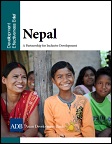 Nepal: Development Effectiveness Brief 2014Nepal has the potential to achieve more inclusive growth and can largely benefit from regional cooperation and integration with its developing neighbors. It is also benefiting from South Asia Subregional Economic Cooperation, a flagship ADB-supported program that promotes economic cooperation and integration in areas of trade facilitation (custom modernization and transport connectivity), power development, trade, and tourism development. This brief further explores ADB’s contribution to inclusive development and poverty reduction, energy, and transport. Exporting energy when surplus is available is one way of meeting seasonal demand by subregional cooperation and power trade. Transport infrastructure is also another key ingredient to equitable, inclusive growth that can address challenges such as lack of market access, inadequate roads, and poor connectivity. Author: Asian Development Bank Year: 2014 Download Tags: Nepal, Regional Cooperation, South Asia, ADB, Connectivity, Energy, Roads, SASEC, Trade, Transport 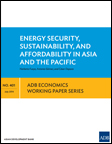 Energy Security, Sustainability, and Affordability in Asia and the PacificEnergy security, sustainability, and affordability from 2010 to 2035 for Asian Development Bank’s Asia and Pacific members are calculated in this working paper, including potential benefits of integrating energy systems regionally. Based on business-as-usual and alternative scenarios, outlook on SASEC member countries by 2035 include (i) dramatic improvement in Bhutan's energy efficiency, (ii) slight decrease in Bangladesh's energy intensity—although carbon dioxide will increase in its primary energy mix, as dependence on fossil fuels rise, and (iii) decrease in energy self-sufficiency of SASEC member countries by 2035, but improved energy affordability. Since renewable energy sources and importation of energy may be capital-intensive, requiring additional tariff support, regional cooperation can enhance affordability and energy security—with Bhutan and Nepal standing to benefit greatly from energy integration in South Asia. Author: Norberto Fueyo, Antonio Gómez, and César Dopazo Year: 2014 Download Tags: Energy, Bhutan, Nepal, Sustainability, Asia-Pacific, ADB, Regional Integration, SASEC, South Asia, Bangladesh, Sustainability, Renewables, Tariff, Regional Cooperation 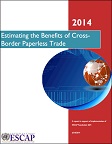 Estimating the Benefits of Cross-Border Paperless TradeCross-border paperless trade is trade that occurs on the basis of electronic communications and has been part of customs reform efforts in a variety of countries. Increased implementation of cross-border paperless trade is high on the trade facilitation agenda in Asia-Pacific. This report considers six measures to calculate estimates of possible economic benefits of cross-border paperless trade through counterfactual simulations using 2013 data and simple econometric models. Simulation results reveal that this new generation of trade facilitation can significantly reduce trade costs and boost intra- and extra-regional trade in the region. Partial implementation of these measures can lead to an export increase of $36 billion annually. Total direct cost savings across all trade is about $1 billion per annum for partial reform, and $7 billion for full implementation. Author: United Nations Economic and Social Commission for Asia and the Pacific Year: 2014 Download Tags: Trade Facilitation, Trade, Asia-Pacific, UNESCAP, Customs, Export, Bangladesh, Bhutan, India, Maldives, Nepal, Sri Lanka 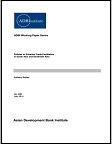 Policies to Enhance Trade Facilitation in South Asia and Southeast AsiaThis Asian Development Bank Institute publication identifies the state of play of trade facilitation and provides an overview of intra- and inter-regional trade in South and Southeast Asia. It highlights key challenges and bottlenecks to effective trade facilitation, ranging from the lack of expert human resources such as information technology specialists in small landlocked countries (Bhutan and Nepal), to the high border transaction costs and severe congestion faced at border crossing points, and the lack of effective dialogue on bilateral enhancement of trade facilitation. Regional initiatives such as the South Asia Subregional Economic Cooperation Program aim to address these challenges through customs modernization and harmonization, automation, and the use of international best practices in border procedures. Author: Anthony Bayley Year: 2014 Download Tags: South Asia, Trade Facilitation, Trade Policy, Southeast Asia, ADB, ICT, Bhutan, Nepal, SASEC, Customs 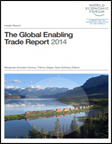 The Global Enabling Trade Report 2014The Global Enabling Trade Report offers a tool to monitor progress on implementing measures for the Trade Facilitation Agreement. Benchmarking the performance of 138 economies in four critical areas, including border administration, the Report takes off from the success of the Bali package by emphasizing measures that facilitate trade at a more practical level, with benefits that significantly outweigh the cost of necessary reforms and produces positive spillover effects on other indicators—market access, infrastructure, and operating environments. Also mentioned are insights on further boosting trade facilitation within the region, such as regional cooperation and sharing of good practices. The Report is intended as a motivator for change at a time of renewed momentum for trade facilitation where windows of opportunities for policymakers to push through trade-enabling measures are open. Author: Margareta Drzeniek Hanouz, Thierry Geiger, Sean Doherty (eds.) Year: 2014 Download Tags: Trade Facilitation, Bangladesh, India, Nepal, South Asia, Sri Lanka 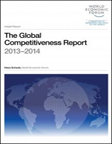 Global Competitiveness Report 2013-2014The World Economic Forum's Global Competitiveness Report offers a platform for dialogue among key stakeholders in government, business, and civil society on improving the living standards of the world’s citizens through insights on institutions, policies, and factors that drive or hinder growth and national competitiveness. Using the Global Competitiveness Index (GCI), twelve pillars are considered, including infrastructure, which, among factor-driven economies of Bangladesh, India, and Nepal, impacts the location of economic activity, reduces distance between regions, and enables production and faster flow of goods. Market size—essential for countries with small domestic markets—is another key index measured. The 2013-2014 report also includes an assessment of newly-covered Bhutan, and an analysis for the drop in India's GCI ranking. Author: Klaus Schwab Year: 2014 Download Tags: Economics, Poverty Reduction, Infrastructure, Bangladesh, Bhutan, Energy, India, Nepal, Sri Lanka, Transport Trade Facilitation and Paperless Trade ImplementationThis paper reports survey findings on progress in implementing various trade facilitation and paperless trade measures made by 29 countries in Asia and the Pacific, including six SASEC member countries. Factors considered include pre-arrival clearance, post-clearance audit, National Single Window, and authorized operator programmes. The survey reveals that while countries have prioritized automation and paperless trade at the regional level, there is an urgent need for regional arrangements that will facilitate cross-border exchange of trade-related electronic documents and information to enable smoother trade facilitation. Author: Tengfei Wang and Yann Duval Year: 2014 Download Tags: Trade Facilitation, Regional Cooperation, Trade, Asia-Pacific, SASEC, Single Window, UNESCAP, Customs, Bangladesh, Bhutan, India, Maldives, Nepal, Sri Lanka 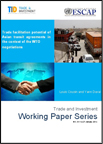 Trade Facilitation Potential of Asian Transit Agreements in the Context of the WTO NegotiationsFreedom of transit is an issue critical to landlocked developing countries whose lack of direct access to the sea has increased costs and lessened their competitiveness in international trade. To meet challenges arising from transit barriers, member states of the United Nations Economic and Social Commission for Asia and the Pacific recommend transit facilitation as part of an integrated approach to trade facilitation.
This working paper analyzes freedom of transit and transit facilitation in the context of trade and transport agreements in the Asia Pacific region, identifying good practices and weighing in on the extent to which existing agreements meet the provisions on transit facilitation stated in the draft text of the World Trade Organization Agreement on Trade Facilitation. Author: Louis Cousin and Yann Duval Year: 2014 Download Tags: Transport Facilitation, Trade Facilitation, WTO, Asia, UNESCAP, Bangladesh, Bhutan, India, Nepal Asian Development Outlook 2014: Fiscal Policy for Inclusive GrowthThe Asian Development Outlook, ADB’s flagship economic publication provides comprehensive macroeconomic analysis in Asia including growth projections by country and region. The Asian Development Outlook 2014 forecasts that developing Asia will grow 6.2% in 2014 and 6.4% in 2015. South Asia remains one of the slowest growing subregions—although growth is forecast to improve by 5.3% in 2014 and 5.8% in 2015. Author: Asian Development Bank Year: 2014 Download Tags: ADB, Bangladesh, Bhutan, Economic Corridor, Energy, India, Maldives, Nepal, Sri Lanka, Transport 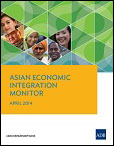 Asian Economic Integration Monitor - April 2014The Asian Economic Integration Monitor, a semiannual review of regional economic cooperation and integration in Asia covers regional economic updates, intraregional trade, financial integration and investment, and the importance of disaster risk financing instruments. The Theme Chapter: Insuring Against Asia’s Natural Catastrophes discusses market solutions and the role of government in developing disaster risk financing and strengthening financial resilience. The economic update section encourages strengthening regional cooperation in surveillance and financial safety nets, and deepening economic links. Inter-subregional trade between each subregion and the rest of Asia is rising, except in South Asia, while financial integration continues to deepen across the region. Author: Asian Development Bank Year: 2014 Download Tags: Regional Cooperation, Regional Integration, South Asia, Disaster Risk, Climate, Bangladesh, Bhutan, India, Maldives, Nepal, Sri Lanka, Transport Lose to Gain: Is Involuntary Resettlement a Development Opportunity?This book examines how displaced persons recover from physical and economic displacement in the South Asian context using resettlement case studies from India, Nepal, and Sri Lanka. Despite improvement in national policies and willingness to enforce good practices, the level of involuntary resettlement good practices in South Asia varies widely. There is need for greater commitment, legal reforms, and adequate resources to ensure that involuntary resettlement becomes a development opportunity for all project-affected persons. Author: Perera, Jayantha (ed.) Year: 2014 Download Tags: India, Nepal, South Asia, Resettlement, Bangladesh, Energy, Renewables, Sri Lanka, Transport Macroeconomic Update: NepalThis issue explores various dimensions of Nepal’s export competitiveness, and stresses the need to address crippling domestic supply-side constraints to boost exports. It suggests that the country needs to properly utilize technical assistance through various financing windows to address constraints such as inadequate infrastructure, political instability, labor disputes, deficiency in human resources and research and development, among others. Author: Asian Development Bank Year: 2014 Download Tags: Economics, Trade Policy, Nepal Asian Market Development and Integration: Challenges and OpportunitiesThis book, co-published by Asian Development Bank (ADB) and Korea Capital Market Institute (KCMI), in collaboration with the Peterson Institute for International Economics, examines the path of capital market development in Asia since the 2008 global crisis. It presents the analytical framework for addressing capital market integration at the regional level and its likely impacts. Author: Asian Development Bank (ADB) and Korea Capital Market Institute(KCMI), eds. Year: 2014 Download Tags: Economics, Trade Policy, Regional Integration, Bangladesh, Bhutan, India, Maldives, Nepal, Sri Lanka South Asia Energy Security: Challenges and OpportunitiesThe imbalance between the growing demand for energy in South Asia and the countries' uneven energy resources has led to weakened energy security in the region. Import dependence from outside the region has become a costly solution. As countries in South Asia move to expand their economies, fostering cross border energy trade and promoting energy investment opportunities could be a better alternative to resolving the energy deficit. However, energy cooperation within South Asia is challenged by major issues that could impede regional energy trade that is beneficial for all. Author: Bhupendra Kumar Singh Year: 2013 Download Tags: Energy, South Asia, Bangladesh, Bhutan, India, Nepal, Pakistan, Sri Lanka, Trade, Hydropower Reducing Poverty by Closing South Asia's Infrastructure GapThis report takes a critical look at inter-and intra-regional infrastructure of South Asia and explores inequality of access across space and time. It gives an approximate total cost of regional infrastructure needs and investment trends in the South Asia region, along with a proposed framework on ranking of infrastructure needs. The report also examines better usage of existing resources and policy options to help the poorest gain better access to infrastructure.
Finally, it recognizes the enormity of infrastructure deficiencies in South Asia and acknowledges that a good mix of infrastructure investment and supportive reform implementation will enable the region to close the infrastructure gap. Author: Luis Andrés, Dan Biller, and Matías Herrera Dappe Year: 2013 Download Tags: Transport, South Asia, Infrastructure, Energy, Roads, Railway, Water Supply, Bangladesh, Bhutan, Nepal, India, Sri Lanka, Maldives ADB Regional Cooperation Operations Business Plan (RCOBP) 2014-2016 for South AsiaADB's third Regional Cooperation Operations Business Plan (RCOBP) 2014-2016 for South Asia under its South Asia Regional Cooperation Strategy (RCS) 2011-2015 details a cumulative indicative lending program of $3.3 billion and maintains focus on improved regional connectivity, increased cross-border trade, and strengthened regional economic cooperation. Author: Asian Development Bank Year: 2013 Download Tags: Regional Cooperation, Regional Integration, Bangladesh, Bhutan, India, Maldives, Nepal, Sri Lanka, Trade Facilitation, Transport, Energy, SAARC Financing Low-Carbon UrbanDevelopment in South Asia: A Post-2012 Context The cities of South Asia are growing at an unprecedented rate. Currently, the region
accounts for 5 of the world's 26 megacities (Delhi, Dhaka, Karachi, Kolkata, and
Mumbai),with Kolkata and Mumbai being the most dense. The urban population in
India is expected to increase by 20.8 percentage points between 2010 and 2050 compared
to 7.8 percentage points in Latin America and the Caribbean. These trends necessitate bold
efforts in project design and financing to steer this rapid urbanization onto an inclusive, green,
and low-carbon urban development path. Author: Asian Development Bank Year: 2013 Download Tags: Climate, Energy, India, South Asia, Kyoto Protocol, Bangladesh, Bhutan, Nepal, India, Maldives, Sri Lanka Aid for Trade: An Investment Benefit Road Map for South AsiaAid for Trade (AfT) came to prominence just over a decade ago at the launch of the
World Trade Organization's Doha Round. With its focus on helping least developed
countries and economies escape the poverty trap, it aims to strengthen their
capabilities to meet market demand and to reduce supply-side constraints such as a lack of
trade infrastructure. Author: Asian Development Bank Year: 2013 Download Tags: Trade Policy, Poverty Reduction, Infrastructure, India, Bangladesh, Bhutan, Maldives, Sri Lanka, Nepal, Trade Facilitation, Transport, Global Value Chains, Exports Energy Outlook for Asia and the Pacific: October 2013The Energy Outlook for Asia and the Pacific aims to support ADB energy sector operations
by providing stakeholders with an energy outlook for the region up to the year 2035.
It attempts to identify policy, social, infrastructure, and technology issues that must be
addressed to meet future energy need of ADB members in Asia and the Pacific. Author: Asian Development Bank Year: 2013 Download Tags: Energy, Infrastructure, Renewables, Hydropower, Transport, Bangladesh, Bhutan, India, Nepal, Maldives, Sri Lanka Climate Action South Asia: Information Update No. 3 (The Economics of Climate Change in South Asia: Adaptation and Impact Assessment)Analyses show that the cost of early action on climate change in South Asia is lower than
the cost of damage brought about by climate change impacts. In physical terms, the region
will face water shortage and agricultural food production losses, which are vital to achieving
poverty reduction and other Millennium Development Goals (MDGs). Author: Asian Development Bank Year: 2013 Download Tags: Economics, Climate, Agriculture, Climate Change, Environment, South Asia, Milennium Development Goals, Sustainability, Bangladesh, Bhutan, India, Nepal, Maldives, Poverty Reduction, Hydropower, Energy Climate Action South Asia: Information Update No. 2 (Economics of Reducing Greenhouse Gas Emissions in South Asia: Options and Costs)The study Economics of Reducing Greenhouse Gas Emissions: Options and Costs in Bangladesh, Bhutan, the Maldives, Nepal, and Sri Lanka reveals excellent opportunities in low-carbon green growth by pursuing resource- and energyefficient technologies that would lower emissions of greenhouse gases at low cost or even cost saving (benefits). Author: Asian Development Bank Year: 2013 Download Tags: Economics, Climate, Climate Change, Economics, South Asia, Bangladesh, Bhutan, Maldives, Sri Lanka, Energy, Environment, Sustainability, ADB, Nepal, Development, Hydropower 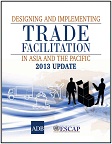 Designing and Implementing Trade Facilitation in Asia and the PacificThis reference book was published to support the implementation of trade facilitation measures and reforms in Asia and the Pacific. It includes operational guidance on assessing the status of trade facilitation, the measures and reforms needed, how to design trade facilitation initiatives, and how to implement them at national and regional levels. The book is intended to assist policy makers, practitioners, and economists by bridging the gap between theory and practice. The revised 2013 version includes updated statistical figures and data, information on actual trade facilitation policies and practices, and the most recent research on trade facilitation. Author: Asian Development Bank / United Nations Economic and Social Commission for Asia and the Pacific Year: 2013 Download Tags: Trade Facilitation, Regional Cooperation, Regional Integration, Trade Policy, Economic Corridor, Sanitary and Phytosanitary Measures, Technical Barriers to Trade, Revised Kyoto Convention, Customs, Customs Valuation, Bangladesh, Bhutan, India, Nepal, Maldives, Sri Lanka, Services Asia-Pacific Trade Facilitation Forum: Survey on Trade Facilitation and Paperless TradeConducted jointly by the Asian Development Bank and the United Nations Economic and Social Commission for Asia and the Pacific, this survey provides a status snapshot of trade facilitation in place across 26 countries of the region, including progress towards establishment of national trade facilitation committees, implementation of risk management measures, development of national single windows, and steps taken to move toward paperless trade. It further examines specific issues and challenges in these areas of South East Asian countries, and provides recommendations for improvement. Author: ADB and UNESCAP Year: 2012 Download Tags: Trade Facilitation, Paperless Trade, Bangladesh, Bhutan, India, Nepal, Maldives, Sri Lanka, Customs, Transport Facilitation, Myanmar, National Single Window Regional Integration and Economic Development in South AsiaSouth Asian leaders have made it a priority to tackle key regional issues such as poverty, environment degradation, trade and investment barriers and food insecurity, among others. This book considers the leadership of the South Asian Association for Regional Cooperation (SAARC) and the interaction with civil society in the process of South Asian regional cooperation and integration, and discusses how the emerging urgency in the provision of regional public goods provides an excellent opportunity to add to the successes in South Asian regional integration. Author: Sultan Hafeez / Rahman Sridhar Khatri / Hans-Peter Brunner Year: 2012 Download Tags: Economic Corridor, Regional Cooperation, Regional Integration, SAARC, SAFTA, Bangladesh, Bhutan, India, Maldives, Nepal, Sri Lanka Sector Roadmaps with Result FrameworksSector roadmaps with result frameworks for transport, energy, and trade facilitation. Author: Asian Development Bank Year: 2011 Download Tags: Trade Facilitation, Energy, Transport, Bangladesh, Bhutan, India, Maldives, Nepal, Sri Lanka Regional Cooperation and Integration Through Cross-Border Insfrastructure Development in South AsiaThis paper aims to identify the links between cross-border infrastructure development and poverty reduction. With South Asia being home to around 40% of the world's poor, there is a great need to boost intraregional trade through greater cooperation and integration. Regional integration promises to increase the region's capacity to connect with global production networks and participate in the global economy with greater efficiency. Author: P.V. Srinivasan Year: 2011 Download Tags: Regional Cooperation, Regional Integration, South Asia, Bangladesh, Bhutan, India, Maldives, Nepal, Sri Lanka, Poverty Reduction South Asia- Intra Regional Cooperation: The Way ForwardThis study aims to showcase the benefits of regional integration and recommends strategies for overcoming the many hurdles. Author: Shahid Kardar Year: 2011 Download Tags: Policy, Economic Cooperation, Regional Integration, Development, SAARC, Non-Tariff Measures, Trade Facilitation, SAFTA, India, Bangladesh, Bhutan, Maldives, Nepal, Sri Lanka, BIMSTEC, Myanmar, SASEC, Energy 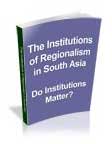 The Institutions of Regionalism in South Asia - Do Institutions Matter?This paper assesses the contribution of key institutions of regional cooperation and integration (RCI) in South Asia, and suggests ways in which the Asian Development Bank and other development partners can strengthen their support. It attempts to enhance understanding on the interplay between politics and RCI, including how good bilateral political relations or improvements have advanced RCI. With the overall political environment growing increasingly open to RCI, the paper suggests the time has come for the South Asian Association for Regional Cooperation (SAARC) to consider strengthening the capacity of the SAARC Secretariat to meet the growing challenges and work load of managing the anticipated increase in RCI. Author: Prabhu Ghate Year: 2011 Download Tags: Regional Cooperation, Regional Integration, Development, SAARC, Trade, Services, Trade Facilitation, Energy, Free Trade Agreements, SAFTA, Bangladesh, Bhutan, India, Maldives, Nepal, Sri Lanka, Transport Energy Trade in South Asia: Opportunities and ChallengesThe South Asia Regional Energy Study was completed as an important component of the regional technical assistance project Preparing the Energy Sector Dialogue and South Asian Association for Regional Cooperation Energy Center Capacity Development. It involved examining regional energy trade opportunities among all the member states of the South Asian Association for Regional Cooperation. The study provides interventions to improve regional energy cooperation in different timescales, including specific infrastructure projects which can be implemented during these periods. Author: Sultan Hafeez Rahman / Priyantha D. C. Wijayatunga / Herath Gunatilake / P. N. Fernando Year: 2011 Download Tags: Energy, Regional Cooperation, Regional Integration, SAARC, Trade, Bangladesh, Bhutan, India, Nepal, Maldives, Sri Lanka The Provision of Regional Public Goods in South AsiaThis report reviews the provision of high priority regional public goods (RPGs) selected
for the South Asia subregion, and proposes areas of cooperation for improving the provisioning of RPGs in South Asia. It highlights the issues in cross border management of infrastructure projects and best practices in the provisioning of RPGs relevant for South Asia, evaluates ADB’s contributions to providing RPGs in the subregion, and concludes with recommendations on ADB’s South Asia Regional Department’s role in the provision of RPGs in the subregion. Author: Khaja Moinuddin Year: 2010 Download Tags: Energy, Agriculture, Disaster Risk, Governance, Poverty Reduction, Bangladesh, Bhutan, India, Maldives, Nepal, Sri Lanka, Trade Facilitation, Transport Binding Contraints to Regional Cooperation and Integration in South AsiaThis paper examines the benefits of regional cooperation and integration, focusing on the cost of neglecting to address the binding constraints to regional cooperation and integration. Component papers in this volume analyze the current state of play, and identifies the binding constraints to achieving more efficient transport corridors, regional energy trade and trade facilitation in the region. Author: Gilberto M. Llanto Year: 2010 Download Tags: Regional Cooperation, Economic Integration, Trade Facilitation, Energy, Bangladesh, Bhutan, India, Maldives, Nepal, Sri Lanka, Transport Infrastructure for a Seamless AsiaThe study reviews regional infrastructure being enhanced through regional cooperation in Asia and examines major issues and challenges. It suggests a framework for pan-Asian infrastructure cooperation, anchored on a long-term vision of creating a seamless Asia that will not only enhance the region's competitiveness and extend its global reach, but also help reduce poverty and promote greater environmental sustainability. Author: Asian Development Bank / Asian Development Bank Institute Year: 2009 Download Tags: Regional Cooperation, Regional Integration, Transport, Trade Facilitation, Connectivity, India, Bangladesh, Bhutan, Nepal, Maldives, Sri Lanka, Asian Highway, Trans-Asian Railway Network, Energy, Myanmar 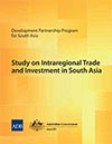 Study on Intraregional Trade and Investment in South AsiaThis study broadens and deepens intraregional cooperation and integration in trade and investment among South Asian countries. It showcases the benefits of regional integration and presents an array of policy recommendations to maximize and realize such gains. Three parallel initiatives are needed: first, reduce nontariff barriers to deepen the South Asian Free Trade Area (SAFTA); second, expand SAFTA's scope to include investments and services; and third, focus on key industries to succinctly demonstrate the process and benefits of reforms. These translate into six component studies: (i) the Role of Trade Facilitation in South Asian Economic Integration; (ii) Country Investment Studies for Bangladesh, India, Nepal, and Sri Lanka; and (iii) Textile and Clothing Industry. The study invigorates the debate and focus on South Asian integration as a means to further growth and reduce poverty. Author: Asian Development Bank / Australian Government Year: 2009 Download Tags: Trade Policy, Trade Facilitation, Regional Cooperation, Regional Integration, Bangladesh, India, Nepal, Sri Lanka, SAFTA Quantification of Benefits from Economic Cooperation in South AsiaThe study examines the implication of the South Asian Free Trade Agreement (SAFTA) on South Asian countries and on the region as a whole, employing both a quantitative and qualitative assessment on the outcomes of SAFTA. The research aims to provide support in the formulation of concrete policy measures for trade to ensure greater gains for the region, while at the same time mitigating potential negative impacts. Economic and social assessments through analytical tools and rational causal chain analysis further enrich the study. Author: Asian Development Bank / United Nations Conference on Trade and Development Year: 2008 Download Tags: Economic Corridor, Regional Cooperation, Regional Integration, SAFTA, Free Trade Agreements, Trade Facilitation, Transport, Services, SAARC, Bangladesh, Bhutan, India, Maldives, Nepal, Sri Lanka Emerging Asian Regionalism-A Partnership for Shared ProsperityThe study summarizes important issues related to Asian regionalism. Viewing regional cooperation as a necessary tool for coping with the consequences of interdependence, the book discusses several pressing issues, such as integrating production, improving financial cooperation, and managing macroeconomic interdependence to create a stable architecture for an Asia-wide cooperation. Author: Asian Development Bank Year: 2008 Download Tags: Economic Corridor, Regional Cooperation, Regional Integration, Asia, ASEAN, SAARC, Bangladesh, Bhutan, India, Nepal, Maldives, Sri Lanka SASEC ICT Development Master PlanThis report represents the first comprehensive multilateral ICT development plan. Its primary objective is to create a framework that will support the already existing ICT plans of Bangladesh, Bhutan, India, and Nepal and help these SASEC countries collaborate more effectively with each other. Author: Asian Development Bank Year: 2006 Download Tags: ICT, Regional Cooperation, Regional Integration, SASEC, Bangladesh, Bhutan, India, Nepal |



